Lamivudine: Difference between revisions
No edit summary |
No edit summary |
||
| (11 intermediate revisions by the same user not shown) | |||
| Line 1: | Line 1: | ||
{{DrugProjectFormSinglePage | {{DrugProjectFormSinglePage | ||
|authorTag={{SG}} | |authorTag={{SG}} | ||
|genericName= | |genericName=lamivudine | ||
|aOrAn=a | |aOrAn=a | ||
|drugClass=[[nucleoside analogue reverse transcriptase inhibitor]] | |drugClass=[[nucleoside analogue reverse transcriptase inhibitor]] | ||
| Line 13: | Line 13: | ||
<i><span style="color:#FF0000;">Exacerbations of Hepatitis B:</span></i> Severe acute exacerbations of hepatitis B have been reported in patients who are co-infected with hepatitis B virus (HBV) and human immunodeficiency virus (HIV-1) and have discontinued lamivudine. Hepatic function should be monitored closely with both clinical and laboratory follow-up for at least several months in patients who discontinue lamivudine and are co-infected with HIV-1 and HBV. If appropriate, initiation of anti-hepatitis B therapy may be warranted. | <i><span style="color:#FF0000;">Exacerbations of Hepatitis B:</span></i> Severe acute exacerbations of hepatitis B have been reported in patients who are co-infected with hepatitis B virus (HBV) and human immunodeficiency virus (HIV-1) and have discontinued lamivudine. Hepatic function should be monitored closely with both clinical and laboratory follow-up for at least several months in patients who discontinue lamivudine and are co-infected with HIV-1 and HBV. If appropriate, initiation of anti-hepatitis B therapy may be warranted. | ||
<i><span style="color:#FF0000;">Important Differences Among Lamivudine-Containing Products:</span></i> Lamivudine tablets (used to treat HIV-1 infection) contain a higher dose of the active ingredient (lamivudine) than | <i><span style="color:#FF0000;">Important Differences Among Lamivudine-Containing Products:</span></i> Lamivudine tablets (used to treat HIV-1 infection) contain a higher dose of the active ingredient (lamivudine) than lamivudine-HBV® tablets and oral solution (used to treat chronic HBV infection). Patients with HIV-1 infection should receive only dosage forms appropriate for treatment of HIV-1. | ||
|fdaLIADAdult=====Human immunodeficiency virus (HIV-1) infection==== | |fdaLIADAdult=====Human immunodeficiency virus (HIV-1) infection==== | ||
*Dosage: 300 mg daily or 150 mg q12h | *Dosage: 300 mg daily or 150 mg q12h | ||
| Line 19: | Line 19: | ||
==== Chronic Hepatitis B (HBV) infection==== | ==== Chronic Hepatitis B (HBV) infection==== | ||
*Dosage: 100 mg daily | *Dosage: 100 mg daily | ||
|offLabelAdultGuideSupport=There is limited information regarding <i>Off-Label Guideline-Supported Use</i> of | |offLabelAdultGuideSupport=There is limited information regarding <i>Off-Label Guideline-Supported Use</i> of lamivudine in adult patients. | ||
|offLabelAdultNoGuideSupport=====Posttransplant Prophylaxis for Hepatitis B==== | |offLabelAdultNoGuideSupport=====Posttransplant Prophylaxis for Hepatitis B==== | ||
*Dosage: 100mg daily <ref name="pmid20659092">{{cite journal| author=Jiang L, Yan L, Li B, Wen T, Zhao J, Jiang L et al.| title=Prophylaxis against hepatitis B recurrence posttransplantation using lamivudine and individualized low-dose hepatitis B immunoglobulin. | journal=Am J Transplant | year= 2010 | volume= 10 | issue= 8 | pages= 1861-9 | pmid=20659092 | doi=10.1111/j.1600-6143.2010.03208.x | pmc= | url=http://www.ncbi.nlm.nih.gov/entrez/eutils/elink.fcgi?dbfrom=pubmed&tool=sumsearch.org/cite&retmode=ref&cmd=prlinks&id=20659092 }} </ref> | *Dosage: 100mg daily <ref name="pmid20659092">{{cite journal| author=Jiang L, Yan L, Li B, Wen T, Zhao J, Jiang L et al.| title=Prophylaxis against hepatitis B recurrence posttransplantation using lamivudine and individualized low-dose hepatitis B immunoglobulin. | journal=Am J Transplant | year= 2010 | volume= 10 | issue= 8 | pages= 1861-9 | pmid=20659092 | doi=10.1111/j.1600-6143.2010.03208.x | pmc= | url=http://www.ncbi.nlm.nih.gov/entrez/eutils/elink.fcgi?dbfrom=pubmed&tool=sumsearch.org/cite&retmode=ref&cmd=prlinks&id=20659092 }} </ref> | ||
| Line 28: | Line 28: | ||
*Dosage: patients aged 2 to 17 years is 3 mg per kg once daily up to a maximum daily dosage of 100 mg. | *Dosage: patients aged 2 to 17 years is 3 mg per kg once daily up to a maximum daily dosage of 100 mg. | ||
*The oral solution formulation should be prescribed for patients requiring a dosage less than 100 mg or if unable to swallow tablets. | *The oral solution formulation should be prescribed for patients requiring a dosage less than 100 mg or if unable to swallow tablets. | ||
|offLabelPedGuideSupport=There is limited information regarding <i>Off-Label Guideline-Supported Use</i> of | |offLabelPedGuideSupport=There is limited information regarding <i>Off-Label Guideline-Supported Use</i> of lamivudine in pediatric patients. | ||
|offLabelPedNoGuideSupport=There is limited information regarding <i>Off-Label Non–Guideline-Supported Use</i> of | |offLabelPedNoGuideSupport=There is limited information regarding <i>Off-Label Non–Guideline-Supported Use</i> of lamivudine in pediatric patients. | ||
|contraindications=*[[Hypersensitivity]] to lamivudine or to any component of the tablets or oral solution. | |contraindications=*[[Hypersensitivity]] to lamivudine or to any component of the tablets or oral solution. | ||
|warnings=====Lactic Acidosis and Severe Hepatomegaly With Steatosis==== | |warnings=====Lactic Acidosis and Severe Hepatomegaly With Steatosis==== | ||
| Line 36: | Line 36: | ||
*[[Obesity]] and prolonged [[nucleoside]] exposure may be risk factors. | *[[Obesity]] and prolonged [[nucleoside]] exposure may be risk factors. | ||
*Particular caution should be exercised when administering | *Particular caution should be exercised when administering lamivudine to any patient with known risk factors for [[liver]] disease; however, cases also have been reported in patients with no known risk factors. Treatment with lamivudine should be suspended in any patient who develops clinical or laboratory findings suggestive of [[lactic acidosis]] or pronounced [[hepatotoxicity]] (which may include [[hepatomegaly]] and [[steatosis]] even in the absence of marked [[transaminase]] elevations). | ||
====Patients With HIV-1 and Hepatitis B Virus Co-infection==== | ====Patients With HIV-1 and Hepatitis B Virus Co-infection==== | ||
| Line 48: | Line 48: | ||
'''Important Differences Among Lamivudine-Containing Products''' | '''Important Differences Among Lamivudine-Containing Products''' | ||
* | *lamivudine Tablets and Oral Solution contain a higher dose of the same active ingredient (lamivudine) than lamivudine-[[HBV]] Tablets and lamivudine-[[HBV]] Oral Solution. | ||
* | * lamivudine-[[HBV]] was developed for patients with chronic [[hepatitis B]]. | ||
* The formulation and dosage of lamivudine in | * The formulation and dosage of lamivudine in lamivudine-HBV are not appropriate for patients co-infected with [[HIV-1]] and [[HBV]]. Safety and efficacy of lamivudine have not been established for treatment of chronic [[hepatitis B]] in patients co-infected with [[HIV-1]] and [[HBV]]. | ||
*If treatment with | *If treatment with lamivudine-HBV is prescribed for chronic [[hepatitis B]] for a patient with unrecognized or untreated [[HIV-1]] infection, rapid emergence of [[HIV-1]] resistance is likely to result because of the subtherapeutic dose and the inappropriateness of monotherapy [[HIV-1]] treatment. | ||
* If a decision is made to administer lamivudine to patients co-infected with [[HIV-1]] and [[HBV]], | * If a decision is made to administer lamivudine to patients co-infected with [[HIV-1]] and [[HBV]], lamivudine Tablets, lamivudine Oral Solution, lamivudine/[[zidovudine]] Tablets, [[abacavir sulfate]] and [[lamivudine]]) Tablets, or [[abacavir sulfate]], lamivudine, and [[zidovudine]]) Tablets should be used as part of an appropriate combination regimen. | ||
'''Emergence of Lamivudine-Resistant HBV''' | '''Emergence of Lamivudine-Resistant HBV''' | ||
| Line 60: | Line 60: | ||
====Use With Other Lamivudine- and Emtricitabine-Containing Products==== | ====Use With Other Lamivudine- and Emtricitabine-Containing Products==== | ||
* | *lamivudine should not be administered concomitantly with other lamivudine-containing products including lamivudine-[[HBV]] Tablets, lamivudine Oral Solution, lamivudine/[[zidovudine]] Tablets, [[abacavir sulfate]] and lamivudine Tablets, or [[abacavir sulfate]], lamivudine, and [[zidovudine]] or [[emtricitabine]]-containing products, including [[efavirenz]], [[emtricitabine]], and [[tenofovir]], [[emtricitabine]], [[emtricitabine]] and [[tenofovir]], or [[rilpivirine]]/[[emtricitabine]]/[[tenofovir]]. | ||
====Use With Interferon- and Ribavirin-Based Regimens==== | ====Use With Interferon- and Ribavirin-Based Regimens==== | ||
*[[In vitro]] studies have shown [[ribavirin]] can reduce the [[phosphorylation]] of [[pyrimidine]] [[nucleoside analogues]] such as lamivudine. | *[[In vitro]] studies have shown [[ribavirin]] can reduce the [[phosphorylation]] of [[pyrimidine]] [[nucleoside analogues]] such as lamivudine. | ||
*Although no evidence of a [[pharmacokinetic]] or [[pharmacodynamic]] interaction (e.g., loss of [[HIV-1]]/[[HCV]] virologic suppression) was seen when [[ribavirin]] was coadministered with lamivudine in [[HIV-1]]/[[HCV]] co-infected patients, hepatic decompensation (some fatal) has occurred in [[HIV-1]]/[[HCV]] co-infected patients receiving combination [[antiretroviral]] therapy for [[HIV-1]] and [[interferon]] alfa with or without [[ribavirin]]. | *Although no evidence of a [[pharmacokinetic]] or [[pharmacodynamic]] interaction (e.g., loss of [[HIV-1]]/[[HCV]] virologic suppression) was seen when [[ribavirin]] was coadministered with lamivudine in [[HIV-1]]/[[HCV]] co-infected patients, hepatic decompensation (some fatal) has occurred in [[HIV-1]]/[[HCV]] co-infected patients receiving combination [[antiretroviral]] therapy for [[HIV-1]] and [[interferon]] alfa with or without [[ribavirin]]. | ||
*Patients receiving [[interferon]] alfa with or without [[ribavirin]] and | *Patients receiving [[interferon]] alfa with or without [[ribavirin]] and lamivudine should be closely monitored for treatment-associated toxicities, especially [[hepatic]] decompensation. *Discontinuation of lamivudine should be considered as medically appropriate. | ||
*Dose reduction or discontinuation of [[interferon]] alfa, [[ribavirin]], or both should also be considered if worsening clinical toxicities are observed, including [[hepatic]] decompensation (e.g., [[Child-Pugh]] >6). | *Dose reduction or discontinuation of [[interferon]] alfa, [[ribavirin]], or both should also be considered if worsening clinical toxicities are observed, including [[hepatic]] decompensation (e.g., [[Child-Pugh]] >6). | ||
====Pancreatitis==== | ====Pancreatitis==== | ||
*In [[pediatric]] patients with a history of prior [[antiretroviral]] [[nucleoside]] exposure, a history of [[pancreatitis]], or other significant risk factors for the development of [[pancreatitis]], | *In [[pediatric]] patients with a history of prior [[antiretroviral]] [[nucleoside]] exposure, a history of [[pancreatitis]], or other significant risk factors for the development of [[pancreatitis]], lamivudine should be used with caution. | ||
*Treatment with | *Treatment with lamivudine should be stopped immediately if clinical signs, symptoms, or laboratory abnormalities suggestive of [[pancreatitis]] occur. | ||
====Immune Reconstitution Syndrome==== | ====Immune Reconstitution Syndrome==== | ||
*[[Immune reconstitution syndrome]] has been reported in patients treated with combination [[antiretroviral]] therapy, including | *[[Immune reconstitution syndrome]] has been reported in patients treated with combination [[antiretroviral]] therapy, including lamivudine. | ||
*During the initial phase of combination [[antiretroviral]] treatment, patients whose [[immune system]] responds may develop an [[inflammatory response]] to indolent or residual [[opportunistic infections]] (such as [[Mycobacterium avium]] infection, [[cytomegalovirus]], [[Pneumocystis jirovecii pneumonia]] [PCP], or [[tuberculosis]]), which may necessitate further evaluation and treatment. | *During the initial phase of combination [[antiretroviral]] treatment, patients whose [[immune system]] responds may develop an [[inflammatory response]] to indolent or residual [[opportunistic infections]] (such as [[Mycobacterium avium]] infection, [[cytomegalovirus]], [[Pneumocystis jirovecii pneumonia]] [PCP], or [[tuberculosis]]), which may necessitate further evaluation and treatment. | ||
*[[Autoimmune disorders]] (such as [[Graves’ disease]], [[polymyositis]], and [[Guillain-Barré syndrome]]) have also been reported to occur in the setting of [[immune reconstitution]], however, the time to onset is more variable, and can occur many months after initiation of treatment. | *[[Autoimmune disorders]] (such as [[Graves’ disease]], [[polymyositis]], and [[Guillain-Barré syndrome]]) have also been reported to occur in the setting of [[immune reconstitution]], however, the time to onset is more variable, and can occur many months after initiation of treatment. | ||
| Line 85: | Line 85: | ||
====Adults Population==== | ====Adults Population==== | ||
======Clinical Trials in HIV-1====== | ======Clinical Trials in HIV-1====== | ||
The safety profile of | The safety profile of lamivudine in adults is primarily based on 3,568 [[HIV-1]]-infected subjects in 7 [[clinical trials]]. | ||
The most common adverse reactions are [[headache]], [[nausea]], [[malaise]], [[fatigue]], nasal signs and symptoms, [[diarrhea]] and [[cough]]. | The most common adverse reactions are [[headache]], [[nausea]], [[malaise]], [[fatigue]], nasal signs and symptoms, [[diarrhea]] and [[cough]]. | ||
Selected clinical adverse reactions in ≥5% of subjects during therapy with | Selected clinical adverse reactions in ≥5% of subjects during therapy with lamivudine 150 mg twice daily plus zidovudine 200 mg 3 times daily for up to 24 weeks are listed in Table 3. | ||
[[File:Adverse effects Lamivudine clinical trials.png|none|600px]] | [[File:Adverse effects Lamivudine clinical trials.png|none|600px]] | ||
'''Pancreatitis''': | '''Pancreatitis''': | ||
[[Pancreatitis]] was observed in 9 out of 2,613 adult subjects (0.3%) who received | [[Pancreatitis]] was observed in 9 out of 2,613 adult subjects (0.3%) who received lamivudine in controlled [[clinical trials]]. | ||
''' | '''Lamivudine 300 mg Once Daily:''' | ||
The types and frequencies of clinical adverse reactions reported in subjects receiving | The types and frequencies of clinical adverse reactions reported in subjects receiving lamivudine 300 mg once daily or lamivudine 150 mg twice daily (in 3-drug combination regimens in EPV20001 and EPV40001) for 48 weeks were similar. | ||
Selected laboratory abnormalities observed during therapy are summarized in Table 4. | Selected laboratory abnormalities observed during therapy are summarized in Table 4. | ||
[[File:Adverse effects Lab Anormalities.png|none|500px]] | [[File:Adverse effects Lab Anormalities.png|none|500px]] | ||
The frequencies of selected laboratory abnormalities reported subjects receiving | The frequencies of selected laboratory abnormalities reported subjects receiving lamivudine 300 mg once daily or lamivudine 150 mg twice daily (in 3-drug combination regimens in EPV20001 and EPV40001) were similar. | ||
====Pediatric Population==== | ====Pediatric Population==== | ||
======Clinical Trials in HIV-1====== | ======Clinical Trials in HIV-1====== | ||
Lamivudine Oral Solution has been studied in 638 [[pediatric]] subjects aged 3 months to 18 years in 3 [[clinical trials]]. | |||
Selected clinical adverse reactions and physical findings with a ≥5% frequency during therapy with | Selected clinical adverse reactions and physical findings with a ≥5% frequency during therapy with lamivudine 4 mg/kg twice daily plus [[zidovudine]] 160 mg/m2 3 times daily in therapy-naive (≤56 days of [[antiretroviral therapy]]) [[pediatric]] subjects are listed in Table 5. | ||
[[File:Lamivudine Adverse effects Pediatric Population.png|none|500px]] | [[File:Lamivudine Adverse effects Pediatric Population.png|none|500px]] | ||
'''Pancreatitis''': | '''Pancreatitis''': | ||
[[Pancreatitis]], which has been fatal in some cases, has been observed in [[antiretroviral]] [[nucleoside]]‑experienced [[pediatric]] subjects receiving | [[Pancreatitis]], which has been fatal in some cases, has been observed in [[antiretroviral]] [[nucleoside]]‑experienced [[pediatric]] subjects receiving lamivudine alone or in combination with other [[antiretroviral agents]]. In an open‑label dose‑escalation trial (NUCA2002), 14 subjects (14%) developed [[pancreatitis]] while receiving monotherapy with lamivudine. Three of these subjects died of complications of [[pancreatitis]]. In a second open‑label trial (NUCA2005), 12 subjects (18%) developed [[pancreatitis]]. In Trial ACTG300, [[pancreatitis]] was not observed in 236 subjects randomized to lamivudine plus [[zidovudine]]. [[Pancreatitis]] was observed in 1 subject in this trial who received open‑label lamivudine in combination with [[zidovudin]] and [[ritonavir]] following discontinuation of [[didanosine]] monotherapy. | ||
'''Paresthesias and Peripheral Neuropathies''': | '''Paresthesias and Peripheral Neuropathies''': | ||
| Line 124: | Line 124: | ||
======Clinical Trials in HIV-1====== | ======Clinical Trials in HIV-1====== | ||
Limited short-term safety information is available from 2 small, uncontrolled trials in South Africa in neonates receiving lamivudine with or without [[zidovudine]] for the first week of life following maternal treatment starting at Week 38 or 36 of gestation. Selected adverse reactions reported in these neonates included increased [[liver function tests]], [[anemia]], [[diarrhea]], [[electrolyte disturbances]], [[hypoglycemia]], [[jaundice]] and [[hepatomegaly]], [[rash]], [[respiratory infections]], and [[sepsis]]; 3 neonates died (1 from [[gastroenteritis]] with [[acidosis]] and [[convulsions]], 1 from traumatic injury, and 1 from unknown causes). Two other nonfatal [[gastroenteritis]] or [[diarrhea]] cases were reported, including 1 with [[convulsions]]; 1 infant had transient [[renal insufficiency]] associated with [[dehydration]]. The absence of control groups limits assessments of causality, but it should be assumed that perinatally exposed infants may be at risk for adverse reactions comparable to those reported in pediatric and adult [[HIV-1]]-infected patients treated with lamivudine-containing combination regimens. Long-term effects of in [[utero]] and infant lamivudine exposure are not known. | Limited short-term safety information is available from 2 small, uncontrolled trials in South Africa in neonates receiving lamivudine with or without [[zidovudine]] for the first week of life following maternal treatment starting at Week 38 or 36 of gestation. Selected adverse reactions reported in these neonates included increased [[liver function tests]], [[anemia]], [[diarrhea]], [[electrolyte disturbances]], [[hypoglycemia]], [[jaundice]] and [[hepatomegaly]], [[rash]], [[respiratory infections]], and [[sepsis]]; 3 neonates died (1 from [[gastroenteritis]] with [[acidosis]] and [[convulsions]], 1 from traumatic injury, and 1 from unknown causes). Two other nonfatal [[gastroenteritis]] or [[diarrhea]] cases were reported, including 1 with [[convulsions]]; 1 infant had transient [[renal insufficiency]] associated with [[dehydration]]. The absence of control groups limits assessments of causality, but it should be assumed that perinatally exposed infants may be at risk for adverse reactions comparable to those reported in pediatric and adult [[HIV-1]]-infected patients treated with lamivudine-containing combination regimens. Long-term effects of in [[utero]] and infant lamivudine exposure are not known. | ||
|postmarketing=In addition to adverse reactions reported from [[clinical trials]], the following adverse reactions have been reported during postmarketing use of | |postmarketing=In addition to adverse reactions reported from [[clinical trials]], the following adverse reactions have been reported during postmarketing use of lamivudine. | ||
Because these reactions are reported voluntarily from a population of unknown size, estimates of frequency cannot be made. | Because these reactions are reported voluntarily from a population of unknown size, estimates of frequency cannot be made. | ||
| Line 166: | Line 166: | ||
*Use of lamivudine in combination with [[zalcitabine]] is not recommended. | *Use of lamivudine in combination with [[zalcitabine]] is not recommended. | ||
=====Trimethoprim/Sulfamethoxazole (TMP | =====Trimethoprim/Sulfamethoxazole (TMP-SMX)===== | ||
*No change in dose of either drug is recommended. | *No change in dose of either drug is recommended. | ||
*There is no information regarding the effect on lamivudine [[pharmacokinetics]] of higher doses of [[TMP]] | *There is no information regarding the effect on lamivudine [[pharmacokinetics]] of higher doses of [[TMP-SMX]] such as those used to treat PCP. | ||
=====Drugs with No Observed Interactions With | =====Drugs with No Observed Interactions With lamivudine===== | ||
*A drug interaction trial showed no clinically significant interaction between | *A drug interaction trial showed no clinically significant interaction between lamivudine and [[zidovudine]]. | ||
|FDAPregCat=C | |FDAPregCat=C | ||
|useInPregnancyFDA=There are no adequate and well-controlled trials of | |useInPregnancyFDA=There are no adequate and well-controlled trials of lamivudine in pregnant women. Animal reproduction studies in rats and rabbits revealed no evidence of [[teratogenicity]]. Increased early embryolethality occurred in rabbits at exposure levels similar to those in humans. Lamivudine should be used during pregnancy only if the potential benefit justifies the potential risk to the fetus. | ||
Lamivudine [[pharmacokinetics]] were studied in pregnant women during 2 clinical trials conducted in South Africa. The trial assessed pharmacokinetics in: 16 women at 36 weeks gestation using 150 mg lamivudine twice daily with [[zidovudine]], 10 women at 38 weeks gestation using 150 mg lamivudine twice daily with [[zidovudine]], and 10 women at 38 weeks gestation using lamivudine 300 mg twice daily without other [[antiretrovirals]]. These trials were not designed or powered to provide efficacy information. Lamivudine [[pharmacokinetics]] in pregnant women were similar to those seen in non-pregnant adults and in postpartum women. Lamivudine concentrations were generally similar in maternal, neonatal, and [[umbilical cord]] serum samples. In a subset of subjects, lamivudine [[amniotic fluid]] specimens were collected following natural rupture of membranes. [[Amniotic fluid]] concentrations of lamivudine were typically 2 times greater than maternal serum levels and ranged from 1.2 to 2.5 mcg/mL (150 mg twice daily) and 2.1 to 5.2 mcg/mL (300 mg twice daily). It is not known whether risks of adverse events associated with lamivudine are altered in pregnant women compared with other [[HIV-1]]-infected patients. | Lamivudine [[pharmacokinetics]] were studied in pregnant women during 2 clinical trials conducted in South Africa. The trial assessed pharmacokinetics in: 16 women at 36 weeks gestation using 150 mg lamivudine twice daily with [[zidovudine]], 10 women at 38 weeks gestation using 150 mg lamivudine twice daily with [[zidovudine]], and 10 women at 38 weeks gestation using lamivudine 300 mg twice daily without other [[antiretrovirals]]. These trials were not designed or powered to provide efficacy information. Lamivudine [[pharmacokinetics]] in pregnant women were similar to those seen in non-pregnant adults and in postpartum women. Lamivudine concentrations were generally similar in maternal, neonatal, and [[umbilical cord]] serum samples. In a subset of subjects, lamivudine [[amniotic fluid]] specimens were collected following natural rupture of membranes. [[Amniotic fluid]] concentrations of lamivudine were typically 2 times greater than maternal serum levels and ranged from 1.2 to 2.5 mcg/mL (150 mg twice daily) and 2.1 to 5.2 mcg/mL (300 mg twice daily). It is not known whether risks of adverse events associated with lamivudine are altered in pregnant women compared with other [[HIV-1]]-infected patients. | ||
| Line 180: | Line 180: | ||
[[Antiretroviral]] Pregnancy Registry: To monitor maternal-fetal outcomes of pregnant women exposed to lamivudine, a Pregnancy Registry has been established. | [[Antiretroviral]] Pregnancy Registry: To monitor maternal-fetal outcomes of pregnant women exposed to lamivudine, a Pregnancy Registry has been established. | ||
|AUSPregCat=B3 | |||
|useInNursing=The Centers for Disease Control and Prevention recommend that [[HIV-1]]-infected mothers in the United States not breastfeed their infants to avoid risking postnatal transmission of [[HIV-1]] infection. Because of the potential for serious adverse reactions in nursing infants and [[HIV-1]] transmission, mothers should be instructed not to breastfeed if they are receiving lamivudine. | |useInNursing=The Centers for Disease Control and Prevention recommend that [[HIV-1]]-infected mothers in the United States not breastfeed their infants to avoid risking postnatal transmission of [[HIV-1]] infection. Because of the potential for serious adverse reactions in nursing infants and [[HIV-1]] transmission, mothers should be instructed not to breastfeed if they are receiving lamivudine. | ||
Lamivudine is excreted into human milk. Samples of breast milk obtained from 20 mothers receiving lamivudine monotherapy (300 mg twice daily) or combination therapy (150 mg lamivudine twice daily and 300 mg zidovudine twice daily) had measurable concentrations of lamivudine. | Lamivudine is excreted into human milk. Samples of breast milk obtained from 20 mothers receiving lamivudine monotherapy (300 mg twice daily) or combination therapy (150 mg lamivudine twice daily and 300 mg zidovudine twice daily) had measurable concentrations of lamivudine. | ||
|useInPed=The safety and effectiveness of twice-daily | |useInPed=The safety and effectiveness of twice-daily lamivudine in combination with other antiretroviral agents have been established in pediatric patients 3 months and older. | ||
|useInGeri=[[Clinical trials]] of | |useInGeri=[[Clinical trials]] of lamivudine did not include sufficient numbers of subjects aged 65 and over to determine whether they respond differently from younger subjects. In general, dose selection for an elderly patient should be cautious, reflecting the greater frequency of decreased [[hepatic]], [[renal]], or [[cardiac]] function, and of concomitant disease or other drug therapy. In particular, because lamivudine is substantially excreted by the [[kidney]] and elderly patients are more likely to have decreased [[renal function]], renal function should be monitored and dosage adjustments should be made accordingly. | ||
|useInRenalImpair=Dosing of | |useInRenalImpair=Dosing of lamivudine is adjusted in accordance with renal function. Dosage adjustments are listed in Table 2. | ||
[[File:Lamivudine dosage in accordance with Creatine Clearance.png|none|550px]] | [[File:Lamivudine dosage in accordance with Creatine Clearance.png|none|550px]] | ||
No additional dosing of | No additional dosing of lamivudine is required after routine (4-hour) hemodialysis or peritoneal dialysis. | ||
Although there are insufficient data to recommend a specific dose adjustment of | Although there are insufficient data to recommend a specific dose adjustment of lamivudine in pediatric patients with renal impairment, a reduction in the dose and/or an increase in the dosing interval should be considered. | ||
|administration=*Oral | |administration=*Oral | ||
|monitoring=*Patients with [[HIV-1]] and [[Hepatitis B]] Virus Co-infection should be closely monitored with both clinical and laboratory follow-up for at least several months after stopping treatment. | |monitoring=*Patients with [[HIV-1]] and [[Hepatitis B]] Virus Co-infection should be closely monitored with both clinical and laboratory follow-up for at least several months after stopping treatment. | ||
|overdose=There is no known antidote for | |overdose=There is no known antidote for lamivudine. One case of an adult ingesting 6 g of lamivudine was reported; there were no clinical signs or symptoms noted and hematologic tests remained normal. Two cases of pediatric overdose were reported in Trial ACTG300. One case involved a single dose of 7 mg/kg of lamivudine; the second case involved use of 5 mg/kg of lamivudine twice daily for 30 days. There were no clinical signs or symptoms noted in either case. Because a negligible amount of lamivudine was removed via (4-hour) hemodialysis, continuous ambulatory peritoneal dialysis, and automated peritoneal dialysis, it is not known if continuous hemodialysis would provide clinical benefit in a lamivudine overdose event. If overdose occurs, the patient should be monitored, and standard supportive treatment applied as required. | ||
|drugBox={{Drugbox2 | |drugBox={{Drugbox2 | ||
| Verifiedfields = changed | | Verifiedfields = changed | ||
| Line 250: | Line 251: | ||
| synonyms = <small>L-2′,3′-dideoxy-3′-thiacytidine</small> | | synonyms = <small>L-2′,3′-dideoxy-3′-thiacytidine</small> | ||
}} | }} | ||
|mechAction=*Lamivudine is an [[antiviral]] agent. | |||
*Intracellularly, lamivudine is [[phosphorylated]] to its active 5′-triphosphate metabolite, lamivudine [[triphosphate]] (3TC-TP). | |||
*The principal mode of action of 3TC-TP is the inhibition of [[HIV-1]] [[reverse transcriptase]] (RT) via DNA chain termination after incorporation of the [[nucleotide]] analogue into viral [[DNA]]. | |||
*3TC-TP is a weak inhibitor of mammalian DNA polymerases α, β, and γ. | |||
|structure=*Lamivudine is a synthetic [[nucleoside]] analogue with activity against [[HIV-1]] and [[HBV]]. | |||
*The chemical name of lamivudine is (2R,cis)-4-amino-1-(2-hydroxymethyl-1,3-oxathiolan-5-yl)-(1H)-pyrimidin-2-one. | |||
*Lamivudine is the (-)enantiomer of a dideoxy analogue of [[cytidine]]. *Lamivudine has also been referred to as (-)2′,3′-dideoxy, 3′-thiacytidine. | |||
*It has a molecular formula of C8H11N3O3S and a molecular weight of 229.3. | |||
*Lamivudine is a white to off-white crystalline solid with a solubility of approximately 70 mg/mL in water at 20°C. | |||
[[File:Lamivudine structure.jpg|none|200px]] | |||
|PD=*There is limited information regarding Pharmacodynamics of lamivudine in the drug label. | |||
|PK=====Pharmacokinetics in Adults==== | |||
*The [[pharmacokinetic]] properties of lamivudine have been studied in asymptomatic, [[HIV-1]]-infected adult subjects after administration of single intravenous (IV) doses ranging from 0.25 to 8 mg/kg, as well as single and multiple (twice-daily regimen) oral doses ranging from 0.25 to 10 mg/kg. | |||
*The [[pharmacokinetic]] properties of lamivudine have also been studied as single and multiple oral doses ranging from 5 mg to 600 mg/day administered to [[HBV]]-infected subjects. | |||
*The steady-state [[pharmacokinetic]] properties of the lamivudine 300-mg tablet once daily for 7 days compared with the lamivudine 150-mg tablet twice daily for 7 days were assessed in a crossover trial in 60 healthy subjects. | |||
*Lamivudine 300 mg once daily resulted in lamivudine exposures that were similar to lamivudine 150 mg twice daily with respect to plasma AUC24,ss; however, Cmax,ss was 66% higher and the trough value was 53% lower compared with the 150-mg twice-daily regimen. | |||
*Intracellular lamivudine [[triphosphate]] exposures in peripheral blood mononuclear cells were also similar with respect to AUC24,ss and Cmax24,ss; however, trough values were lower compared with the 150-mg twice-daily regimen. *Inter-subject variability was greater for intracellular lamivudine [[triphosphate]] concentrations versus lamivudine plasma trough concentrations. | |||
*The clinical significance of observed differences for both plasma lamivudine concentrations and intracellular lamivudine [[triphosphate]] concentrations is not known. | |||
======Absorption and Bioavailability====== | |||
*Lamivudine was rapidly absorbed after oral administration in [[HIV-1]]-infected subjects. | |||
*Absolute bioavailability in 12 adult subjects was 86% ± 16% (mean ± SD) for the 150-mg tablet and 87% ± 13% for the oral solution. | |||
*After oral administration of 2 mg/kg twice a day to 9 adults with [[HIV-1]], the peak serum lamivudine concentration (Cmax) was 1.5 ± 0.5 mcg/mL (mean ± SD). | |||
*The area under the plasma concentration versus time curve (AUC) and Cmax increased in proportion to oral dose over the range from 0.25 to 10 mg/kg. | |||
*The accumulation ratio of lamivudine in [[HIV-1]]-positive asymptomatic adults with normal [[renal function]] was 1.50 following 15 days of oral administration of 2 mg/kg twice daily. | |||
======Effects of Food on Oral Absorption====== | |||
*An investigational 25-mg dosage form of lamivudine was administered orally to 12 asymptomatic, [[HIV-1]]-infected subjects on 2 occasions, once in the fasted state and once with food (1,099 kcal; 75 grams fat, 34 grams protein, 72 grams carbohydrate). Absorption of lamivudine was slower in the fed state (Tmax: 3.2 ± 1.3 hours) compared with the fasted state (Tmax: 0.9 ± 0.3 hours); Cmax in the fed state was 40% ± 23% (mean ± SD) lower than in the fasted state. There was no significant difference in systemic exposure (AUC∞) in the fed and fasted states; therefore, lamivudine Tablets and Oral Solution may be administered with or without food. | |||
======Distribution====== | |||
*The apparent volume of distribution after IV administration of lamivudine to 20 subjects was 1.3 ± 0.4 L/kg, suggesting that lamivudine distributes into extravascular spaces. | |||
*Volume of distribution was independent of dose and did not correlate with body weight. | |||
*Binding of lamivudine to human plasma proteins is low (<36%). | |||
*[[In vitro]] studies showed that over the concentration range of 0.1 to 100 mcg/mL, the amount of lamivudine associated with [[erythrocytes]] ranged from 53% to 57% and was independent of concentration. | |||
======Metabolism====== | |||
*Metabolism of lamivudine is a minor route of elimination. | |||
*In man, the only known metabolite of lamivudine is the trans-sulfoxide metabolite. Within 12 hours after a single oral dose of lamivudine in 6 [[HIV-1]]-infected adults, 5.2% ± 1.4% (mean ± SD) of the dose was excreted as the trans-sulfoxide metabolite in the [[urine]]. Serum concentrations of this metabolite have not been determined. | |||
======Elimination====== | |||
*The majority of lamivudine is eliminated unchanged in urine by active organic cationic secretion. | |||
*In 9 healthy subjects given a single 300-mg oral dose of lamivudine, renal clearance was 199.7 ± 56.9 mL/min (mean ± SD). | |||
*In 20 [[HIV-1]]-infected subjects given a single IV dose, [[renal clearance]] was 280.4 ± 75.2 mL/min (mean ± SD), representing 71% ± 16% (mean ± SD) of total clearance of lamivudine. | |||
*In most single-dose trials in [[HIV-1]]-infected subjects, [[HBV]]‑infected subjects, or healthy subjects with serum sampling for 24 hours after dosing, the observed mean elimination half-life (t½) ranged from 5 to 7 hours. | |||
*In [[HIV-1]]-infected subjects, total clearance was 398.5 ± 69.1 mL/min (mean ± SD). | |||
*Oral clearance and elimination half-life were independent of dose and body weight over an oral dosing range of 0.25 to 10 mg/kg. | |||
====Special Populations==== | |||
======Renal Impairment====== | |||
*The pharmacokinetic properties of lamivudine have been determined in a small group of [[HIV-1]]-infected adults with impaired [[renal function]] (Table 7). | |||
[[File:Lamivudine pharmacokinetics special populations.png|none|500px]] | |||
*Exposure (AUC∞), Cmax, and half-life increased with diminishing renal function (as expressed by creatinine clearance). | |||
*Apparent total oral clearance (Cl/F) of lamivudine decreased as creatinine clearance decreased. Tmax was not significantly affected by [[renal function]]. *Based on these observations, it is recommended that the dosage of lamivudine be modified in patients with renal impairment. | |||
*Based on a trial in otherwise healthy subjects with impaired [[renal function]], hemodialysis increased lamivudine clearance from a mean of 64 to 88 mL/min; however, the length of time of hemodialysis (4 hours) was insufficient to significantly alter mean lamivudine exposure after a single-dose administration. | |||
*Continuous ambulatory [[peritoneal dialysis]] and automated [[peritoneal dialysis]] have negligible effects on lamivudine clearance. Therefore, it is recommended, following correction of dose for [[creatinine clearance]], that no additional dose modification be made after routine [[hemodialysis]] or [[peritoneal dialysis]]. | |||
*It is not known whether lamivudine can be removed by continuous (24-hour) [[hemodialysis]]. | |||
*The effects of renal impairment on lamivudine [[pharmacokinetic]]s in pediatric patients are not known. | |||
======Hepatic Impairment====== | |||
*The [[pharmacokinetic]] properties of lamivudine have been determined in adults with impaired hepatic function. | |||
*[[Pharmacokinetic]] parameters were not altered by diminishing hepatic function; therefore, no dose adjustment for lamivudine is required for patients with impaired hepatic function. | |||
*Safety and efficacy of lamivudine have not been established in the presence of decompensated [[liver disease]]. | |||
====Pharmacokinetics in Pediatric Patients==== | |||
*In Trial NUCA2002, [[pharmacokinetic]] properties of lamivudine were assessed in a subset of 57 [[HIV-1]]-infected [[pediatric]] subjects (age range: 4.8 months to 16 years, weight range: 5 to 66 kg) after oral and IV administration of 1, 2, 4, 8, 12, and 20 mg/kg/day. | |||
*In the 9 infants and children (age range: 5 months to 12 years) receiving oral solution 4 mg/kg twice daily (the usual recommended [[pediatric]] dose), absolute bioavailability was 66% ± 26% (mean ± SD), which was less than the 86% ± 16% (mean ± SD) observed in adults. | |||
*The mechanism for the diminished absolute bioavailability of lamivudine in infants and children is unknown. | |||
Systemic clearance decreased with increasing age in [[pediatric]] subjects, as shown in Figure 1. | |||
[[File:Lamivudine Systemic Clearance in Relation to Age.png|none|500px]] | |||
*After oral administration of lamivudine 4 mg/kg twice daily to 11 pediatric subjects ranging in age from 4 months to 14 years, Cmax was 1.1 ± 0.6 mcg/mL and half-life was 2.0 ± 0.6 hours. (In adults with similar blood sampling, the half‑life was 3.7 ± 1 hours.) | |||
*Total exposure to lamivudine, as reflected by mean AUC values, was comparable between [[pediatric]] subjects receiving an 8-mg/kg/day dose and adults receiving a 4-mg/kg/day dose. | |||
*Distribution of lamivudine into [[cerebrospinal fluid]] (CSF) was assessed in 38 [[pediatric]] subjects after multiple oral dosing with lamivudine. | |||
*[[CSF]] samples were collected between 2 and 4 hours postdose. | |||
*At the dose of 8 mg/kg/day, CSF lamivudine concentrations in 8 subjects ranged from 5.6% to 30.9% (mean ± SD of 14.2% ± 7.9%) of the concentration in a simultaneous serum sample, with CSF lamivudine concentrations ranging from 0.04 to 0.3 mcg/mL. | |||
*Limited, uncontrolled [[pharmacokinetic]] and safety data are available from administration of lamivudine (and [[zidovudine]]) to 36 infants aged up to 1 week in 2 trials in South Africa. In these trials, lamivudine clearance was substantially reduced in 1-week-old [[neonates]] relative to [[pediatric]] subjects (aged >3 months) studied previously. | |||
*There is insufficient information to establish the time course of changes in clearance between the immediate [[neonatal]] period and the age-ranges >3 months old. | |||
====Pharmacokinetics in Geriatric Patients==== | |||
*The pharmacokinetics of lamivudine after administration of lamivudine to patients over 65 years have not been studied. | |||
====Drug Interactions==== | |||
======Interferon Alfa====== | |||
*There was no significant [[pharmacokineti]] interaction between lamivudine and [[interferon]] alfa in a trial of 19 healthy male subjects. | |||
======Ribavirin====== | |||
*[[In vitro]] data indicate [[ribavirin]] reduces phosphorylation of lamivudine, [[stavudine]], and [[zidovudine]]. However, no [[pharmacokinetic]] (e.g., plasma concentrations or intracellular triphosphorylated active metabolite concentrations) or [[pharmacodynamic]] (e.g., loss of [[HIV-1]]/[[HCV]] virologic suppression) interaction was observed when [[ribavirin]] and lamivudine (n = 18), [[stavudine]] (n = 10), or [[zidovudine]] (n = 6) were coadministered as part of a multi-drug regimen to [[HIV-1]]/[[HCV]] co-infected subjects. | |||
======Trimethoprim/Sulfamethoxazole====== | |||
*Lamivudine and [[TMP-SMX]] were coadministered to 14 [[HIV-1]]-positive subjects in a single-center, open-label, randomized, crossover trial. Each subject received treatment with a single 300-mg dose of lamivudine and [[TMP]] 160 mg/SMX 800 mg once a day for 5 days with concomitant administration of lamivudine 300 mg with the fifth dose in a crossover design. | |||
*Coadministration of [[TMP-SMX]] with lamivudine resulted in an increase of 43% ± 23% (mean ± SD) in lamivudine AUC∞, a decrease of 29% ± 13% in lamivudine oral clearance, and a decrease of 30% ± 36% in lamivudine [[renal clearance]]. *The [[pharmacokinetic]] properties of [[TMP]] and SMX were not altered by coadministration with lamivudine. | |||
======Zidovudine====== | |||
*No clinically significant alterations in lamivudine or [[zidovudine]] [[pharmacokinetics]] were observed in 12 asymptomatic [[HIV-1]]-infected adult subjects given a single dose of [[zidovudine]] (200 mg) in combination with multiple doses of lamivudine (300 mg q 12 hr). | |||
|nonClinToxic======Carcinogenesis, Mutagenesis, Impairment of Fertility===== | |nonClinToxic======Carcinogenesis, Mutagenesis, Impairment of Fertility===== | ||
Long-term [[carcinogenicity]] studies with lamivudine in mice and rats showed no evidence of [[carcinogenic]] potential at exposures up to 10 times (mice) and 58 times (rats) those observed in humans at the recommended therapeutic dose for [[HIV-1]] infection. Lamivudine was not active in a microbial mutagenicity screen or an [[in vitro]] cell transformation assay, but showed weak [[in vitro]] [[mutagenic]] activity in a [[cytogenetic]] assay using cultured human [[lymphocytes]] and in the mouse [[lymphoma]] assay. However, lamivudine showed no evidence of in vivo genotoxic activity in the rat at oral doses of up to 2,000 mg/kg, producing plasma levels of 35 to 45 times those in humans at the recommended dose for [[HIV-1]] infection. In a study of reproductive performance, lamivudine administered to rats at doses up to 4,000 mg/kg/day, producing plasma levels 47 to 70 times those in humans, revealed no evidence of impaired fertility and no effect on the survival, growth, and development to weaning of the offspring. | Long-term [[carcinogenicity]] studies with lamivudine in mice and rats showed no evidence of [[carcinogenic]] potential at exposures up to 10 times (mice) and 58 times (rats) those observed in humans at the recommended therapeutic dose for [[HIV-1]] infection. Lamivudine was not active in a microbial mutagenicity screen or an [[in vitro]] cell transformation assay, but showed weak [[in vitro]] [[mutagenic]] activity in a [[cytogenetic]] assay using cultured human [[lymphocytes]] and in the mouse [[lymphoma]] assay. However, lamivudine showed no evidence of in vivo genotoxic activity in the rat at oral doses of up to 2,000 mg/kg, producing plasma levels of 35 to 45 times those in humans at the recommended dose for [[HIV-1]] infection. In a study of reproductive performance, lamivudine administered to rats at doses up to 4,000 mg/kg/day, producing plasma levels 47 to 70 times those in humans, revealed no evidence of impaired fertility and no effect on the survival, growth, and development to weaning of the offspring. | ||
| Line 255: | Line 355: | ||
=====Reproductive Toxicology Studies===== | =====Reproductive Toxicology Studies===== | ||
Reproduction studies have been performed in rats and rabbits at orally administered doses up to 4,000 mg/kg/day and 1,000 mg/kg/day, respectively, producing plasma levels up to approximately 35 times that for the adult [[HIV]] dose. No evidence of [[teratogenicity]] due to lamivudine was observed. Evidence of early embryolethality was seen in the rabbit at exposure levels similar to those observed in humans, but there was no indication of this effect in the rat at exposure levels up to 35 times those in humans. Studies in pregnant rats and rabbits showed that lamivudine is transferred to the [[fetus]] through the [[placenta]]. | Reproduction studies have been performed in rats and rabbits at orally administered doses up to 4,000 mg/kg/day and 1,000 mg/kg/day, respectively, producing plasma levels up to approximately 35 times that for the adult [[HIV]] dose. No evidence of [[teratogenicity]] due to lamivudine was observed. Evidence of early embryolethality was seen in the rabbit at exposure levels similar to those observed in humans, but there was no indication of this effect in the rat at exposure levels up to 35 times those in humans. Studies in pregnant rats and rabbits showed that lamivudine is transferred to the [[fetus]] through the [[placenta]]. | ||
|alcohol=Alcohol- | |clinicalStudies=The use of lamivudine is based on the results of [[clinical trials]] in [[HIV‑1]]-infected subjects in combination regimens with other [[antiretroviral]] agents. Information from trials with clinical endpoints or a combination of [[CD4+]] cell counts and [[HIV-1]] [[RNA]] measurements is included below as documentation of the contribution of lamivudine to a combination regimen in controlled trials. | ||
|brandNames=* | |||
====Adults==== | |||
=====Clinical Endpoint Trial===== | |||
NUCB3007 (CAESAR) was a multi-center, [[double-blind]], [[placebo]]-controlled trial comparing continued current therapy ([[zidovudine]] alone [62% of subjects] or [[zidovudine]] with [[didanosine]] or [[zalcitabine]] [38% of subjects]) to the addition of lamivudine or lamivudine plus an investigational [[non-nucleoside reverse transcriptase inhibitor]] (NNRTI), randomized 1:2:1. A total of 1,816 [[HIV-1]]-infected adults with 25 to 250 [[CD4+]] cells/mm3 (median = 122 cells/mm3) at baseline were enrolled: median age was 36 years, 87% were male, 84% were [[nucleoside]]-experienced, and 16% were therapy-naive. The median duration on trial was 12 months. Results are summarized in Table 8. | |||
[[File:Lamivudine NUCB3007 (CAESAR) clinical trial.png|none|500px]] | |||
=====Surrogate Endpoint Trials===== | |||
'''Dual Nucleoside Analogue Trials:'''<br> | |||
Principal [[clinical trial]] in the initial development of lamivudine compared lamivudine/[[zidovudine]] combinations with [[zidovudine]] monotherapy or with [[zidovudine]] plus [[zalcitabine]]. These trials demonstrated the antiviral effect of lamivudine in a 2-drug combination. More recent uses of lamivudine in treatment of [[HIV-1]] infection incorporate it into multiple-drug regimens containing at least 3 [[antiretroviral]] drugs for enhanced viral suppression. | |||
'''Dose Regimen Comparison Surrogate Endpoint Trials in Therapy-Naive Adults:'''<br> | |||
EPV20001 was a multi-center, [[double-blind]], controlled trial in which subjects were randomized 1:1 to receive lamivudine 300 mg once daily or lamivudine 150 mg twice daily, in combination with [[zidovudine]] 300 mg twice daily and [[efavirenz]] 600 mg once daily. A total of 554 [[antiretroviral]] treatment-naive [[HIV-1]]-infected adults enrolled: male (79%), Caucasian (50%), median age of 35 years, baseline [[CD4+]] cell counts of 69 to 1,089 cells/mm3 (median = 362 cells/mm3), and median baseline plasma HIV-1 RNA of 4.66 log10 copies/mL. Outcomes of treatment through 48 weeks are summarized in Figure 2 and Table 9. | |||
[[File:Lamivudine Dose Regimen Comparison Surrogate Endpoint Trials in Therapy-Naive Adults.png|none|600px]] | |||
Roche AMPLICOR HIV-1 MONITOR.<br> | |||
Responders at each visit are subjects who had achieved and maintained HIV-1 RNA <400 copies/mL without discontinuation by that visit. | |||
[[File:Lamivudine Trials in Therapy Naive Adults.png|none|500px]] | |||
The proportions of subjects with [[HIV-1]] [[RNA]] <50 copies/mL (via Roche Ultrasensitive assay) through Week 48 were 61% for subjects receiving lamivudine 300 mg once daily and 63% for subjects receiving lamivudine 150 mg twice daily. Median increases in [[CD4+]] cell counts were 144 cells/mm3 at Week 48 in subjects receiving lamivudine 300 mg once daily and 146 cells/mm3for subjects receiving lamivudine 150 mg twice daily. | |||
A small, randomized, open-label pilot trial, EPV40001, was conducted in Thailand. A total of 159 treatment-naive adult subjects (male 32%, Asian 100%, median age 30 years, baseline median [[CD4+]] cell count 380 cells/mm3, median plasma [[HIV-1]] [[RNA]] 4.8 log10 copies/mL) were enrolled. Two of the treatment arms in this trial provided a comparison between lamivudine 300 mg once daily (n = 54) and lamivudine 150 mg twice daily (n = 52), each in combination with [[zidovudine]] 300 mg twice daily and [[abacavir]] 300 mg twice daily. In intent-to-treat analyses of 48-week data, the proportions of subjects with [[HIV-1]] [[RNA]] below 400 copies/mL were 61% (33/54) in the group randomized to once-daily lamivudine and 75% (39/52) in the group randomized to receive all 3 drugs twice daily; the proportions with [[HIV-1]] [[RNA]] below 50 copies/mL were 54% (29/54) in the once-daily lamivudine group and 67% (35/52) in the all-twice-daily group; and the median increases in [[CD4+]] cell counts were 166 cells/mm3 in the once-daily lamivudine group and 216 cells/mm3 in the all-twice-daily group. | |||
====Pediatric Subjects==== | |||
'''Clinical Endpoint Trial:'''<br> | |||
ACTG300 was a multi-center, randomized, [[double-blind]] trial that provided for comparison of lamivudine plus [[zidovudine]] with [[didanosine]] monotherapy. A total of 471 symptomatic, [[HIV-1]]-infected therapy-naive (56 days of [[antiretroviral therapy]]) [[pediatric]] subjects were enrolled in these 2 treatment arms. The median age was 2.7 years (range: 6 weeks to 14 years), 58% were female, and 86% were non-Caucasian. The mean baseline [[CD4+]] cell count was 868 cells/mm3 (mean: 1,060 cells/mm3 and range:0 to 4,650 cells/mm3 for subjects aged 5 years; mean: 419 cells/mm3 and range: 0 to 1,555 cells/mm3 for subjects aged >5 years) and the mean baseline plasma [[HIV-1]] [[RNA]] was 5.0 log10 copies/mL. The median duration on trial was 10.1 months for the subjects receiving lamivudine plus [[zidovudine]] and 9.2 months for subjects receiving [[didanosine]] monotherapy.<br> | |||
Results are summarized in Table 10. | |||
[[File:Lamivudine Pediatrics Trials.png|none|500px]] | |||
|howSupplied======Lamivudine Tablets, 150 mg===== | |||
*White, diamond-shaped, scored, film-coated tablets debossed with “GX CJ7” on both sides. | |||
*Bottle of 60 tablets (NDC 49702-203-18) with child-resistant closure. | |||
=====Lamivudine Tablets, 300 mg===== | |||
*Gray, modified diamond-shaped, film-coated tablets engraved with “GX EJ7” on one side and plain on the reverse side. | |||
*Bottle of 30 tablets (NDC 49702-204-13) with child-resistant closure. | |||
=====Lamivunide Oral Solution, 10 mg/mL===== | |||
*A clear, colorless to pale yellow, strawberry-banana-flavored liquid, contains 10 mg of lamivudine in each 1 mL. | |||
*Plastic bottle of 240 mL (NDC 49702-205-48) with child-resistant closure. This product does not require reconstitution. | |||
|storage======Lamivudine tablets===== | |||
*Store Lamivudine Tablets at 25°C (77°F); excursions permitted to 15° to 30°C (59° to 86°F). | |||
=====Lamivudine oral solution===== | |||
*Store in tightly closed bottles at 25°C (77°F). | |||
|packLabel=[[File:FDA package label Lamivudine Tablet, film coated.png|none|500px]] | |||
[[File:FDA package label Lamivudine solution.png|none|500px]] | |||
[[File:FDA package label Lamivudine tablets 2.png|none|500px]] | |||
|fdaPatientInfo=====Advice for the Patient==== | |||
======Lactic Acidosis/Hepatomegaly====== | |||
*Patients should be informed that some [[HIV]] medicines, including lamivudine, can cause a rare, but serious condition called [[lactic acidosis]] with liver enlargement ([[hepatomegaly]]). | |||
======HIV-1/HBV Co-infection====== | |||
*Patients co-infected with [[HIV-1]] and [[HBV]] should be informed that deterioration of [[liver disease]] has occurred in some cases when treatment with lamivudine was discontinued. | |||
*Patients should be advised to discuss any changes in regimen with their physician. | |||
======Differences in Formulations of lamivudine====== | |||
Patients should be advised that lamivudine Tablets and Oral Solution contain a higher dose of the same active ingredient (lamivudine) as lamivudine-[[HBV]] Tablets and Oral Solution. If a decision is made to include lamivudine in the [[HIV-1]] treatment regimen of a patient co-infected with [[HIV-1]] and [[HBV]], the formulation and dosage of lamivudine in lamivudine (not lamivudine-[[HBV]]) should be used. | |||
======Use With Other Lamivudine- and Emtricitabine-Containing Products====== | |||
Lamivudine should not be coadministered with drugs containing lamivudine or [[emtricitabine]], including lamivudine/[[zidovudine]] Tablets, [[abacavir sulfate]] and lamivudine Tablets, [[abacavir sulfate]], lamivudine, and [[zidovudine]], [[efavirenz]], [[emtricitabine]], and [[tenofovir]], [emtricitabine], [[emtricitabine]] and [[tenofovir]], or [[rilpivirine]]/[[emtricitabine]]/[[tenofovir]]. | |||
======HIV-1/HCV Co-Infection====== | |||
Patients with [[HIV-1]]/[[HCV]] co-infection should be informed that hepatic decompensation (some fatal) has occurred in [[HIV-1]]/[[HCV]] co-infected patients receiving combination [[antiretroviral therapy]] for [[HIV-1]] and [[interferon]] alfa with or without [[ribavirin]]. | |||
======Risk of Pancreatitis====== | |||
Parents or guardians should be advised to monitor [[pediatric]] patients for signs and symptoms of [[pancreatitis]]. | |||
======Redistribution/Accumulation of Body Fat====== | |||
Patients should be informed that redistribution or accumulation of body fat may occur in patients receiving [[antiretroviral therapy]], including lamivudine, and that the cause and long-term health effects of these conditions are not known at this time. | |||
======Sucrose Content of lamivudine Oral Solution====== | |||
Diabetic patients should be advised that each 15-mL dose of lamivudine Oral Solution contains 3 grams of sucrose. | |||
======Information About HIV-1 Infection====== | |||
Lamivudine is not a cure for [[HIV-1]] infection and patients may continue to experience illnesses associated with [[HIV-1]] infection, including [[opportunistic infections]]. Patients should remain under the care of a physician when using lamivudine. | |||
Patients should be advised to avoid doing things that can spread [[HIV-1]] infection to others. | |||
*Do not share needles or other injection equipment. | |||
*Do not share personal items that can have blood or body fluids on them, like toothbrushes and razor blades. | |||
*Do not have any kind of sex without protection. | |||
*Always practice safe sex by using a latex or polyurethane condom or other barrier method to lower the chance of sexual contact with semen, vaginal secretions, or blood. | |||
*Do not breastfeed. Lamivudine is excreted in human breast milk. Mothers with [[HIV-1]] should not breastfeed because [[HIV-1]] can be passed to the baby in the breast milk. | |||
*Patients should be informed to take all [[HIV]] medications exactly as prescribed. | |||
|alcohol=Alcohol-lamivudine interaction has not been established. Talk to your doctor about the effects of taking alcohol with this medication. | |||
|brandNames=*EPIVIR<ref>{{cite web|url=http://dailymed.nlm.nih.gov/dailymed/drugInfo.cfm?setid=89226149-47fa-4f7d-bb1f-1aa7034486b8|title= lamivudine- lamivudine tablet, film coated. lamivudine- lamivudine solution}} </ref> | |||
*EPIVIR HBV | |||
*EPIVIR A/F | |||
}} | |||
{{LabelImage | |||
|fileName=Lamivudine Package Tablets 1.png | |||
}} | |||
{{LabelImage | |||
|fileName=Lamivudine Package Tablets 2.png | |||
}} | |||
{{LabelImage | |||
|fileName=Lamivudine Package Oral Solution.png | |||
}} | }} | ||
Latest revision as of 13:52, 7 January 2015
Editor-In-Chief: C. Michael Gibson, M.S., M.D. [1]; Associate Editor(s)-in-Chief: Stefano Giannoni [2]
Disclaimer
WikiDoc MAKES NO GUARANTEE OF VALIDITY. WikiDoc is not a professional health care provider, nor is it a suitable replacement for a licensed healthcare provider. WikiDoc is intended to be an educational tool, not a tool for any form of healthcare delivery. The educational content on WikiDoc drug pages is based upon the FDA package insert, National Library of Medicine content and practice guidelines / consensus statements. WikiDoc does not promote the administration of any medication or device that is not consistent with its labeling. Please read our full disclaimer here.
Black Box Warning
|
WARNING: RISK OF LACTIC ACIDOSIS, EXACERBATIONS OF HEPATITIS B IN CO-INFECTED PATIENTS UPON DISCONTINUATION OF LAMIVUDINE, DIFFERENT FORMULATIONS OF LAMIVUDINE.
See full prescribing information for complete Boxed Warning.
Lactic Acidosis and Severe Hepatomegaly: Lactic acidosis and severe hepatomegaly with steatosis, including fatal cases, have been reported with the use of nucleoside analogues alone or in combination, including lamivudine and other antiretrovirals. Suspend treatment if clinical or laboratory findings suggestive of lactic acidosis or pronounced hepatotoxicity occur.
Exacerbations of Hepatitis B: Severe acute exacerbations of hepatitis B have been reported in patients who are co-infected with hepatitis B virus (HBV) and human immunodeficiency virus (HIV-1) and have discontinued lamivudine. Hepatic function should be monitored closely with both clinical and laboratory follow-up for at least several months in patients who discontinue lamivudine and are co-infected with HIV-1 and HBV. If appropriate, initiation of anti-hepatitis B therapy may be warranted. Important Differences Among Lamivudine-Containing Products: Lamivudine tablets (used to treat HIV-1 infection) contain a higher dose of the active ingredient (lamivudine) than lamivudine-HBV® tablets and oral solution (used to treat chronic HBV infection). Patients with HIV-1 infection should receive only dosage forms appropriate for treatment of HIV-1. |
Overview
Lamivudine is a nucleoside analogue reverse transcriptase inhibitor that is FDA approved for the treatment of HIV-1 infection. There is a Black Box Warning for this drug as shown here. Common adverse reactions include headache, nausea, malaise and fatigue, nasal signs and symptoms, diarrhea, and cough..
Adult Indications and Dosage
FDA-Labeled Indications and Dosage (Adult)
Human immunodeficiency virus (HIV-1) infection
- Dosage: 300 mg daily or 150 mg q12h
- In combination with other antiretroviral agents.
Chronic Hepatitis B (HBV) infection
- Dosage: 100 mg daily
Off-Label Use and Dosage (Adult)
Guideline-Supported Use
There is limited information regarding Off-Label Guideline-Supported Use of lamivudine in adult patients.
Non–Guideline-Supported Use
Posttransplant Prophylaxis for Hepatitis B
- Dosage: 100mg daily [1]
- In combination with HBIG.
Pediatric Indications and Dosage
FDA-Labeled Indications and Dosage (Pediatric)
Human immunodeficiency virus (HIV-1) infection
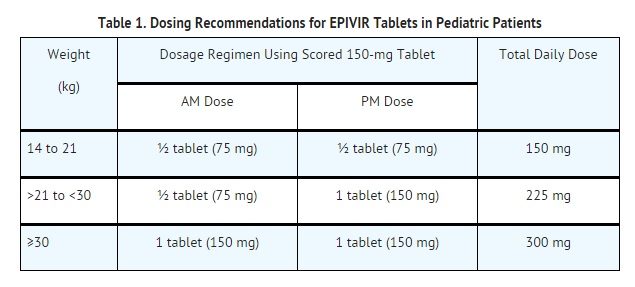
Chronic Hepatitis B (HBV) infection
- Dosage: patients aged 2 to 17 years is 3 mg per kg once daily up to a maximum daily dosage of 100 mg.
- The oral solution formulation should be prescribed for patients requiring a dosage less than 100 mg or if unable to swallow tablets.
Off-Label Use and Dosage (Pediatric)
Guideline-Supported Use
There is limited information regarding Off-Label Guideline-Supported Use of lamivudine in pediatric patients.
Non–Guideline-Supported Use
There is limited information regarding Off-Label Non–Guideline-Supported Use of lamivudine in pediatric patients.
Contraindications
- Hypersensitivity to lamivudine or to any component of the tablets or oral solution.
Warnings
|
WARNING: RISK OF LACTIC ACIDOSIS, EXACERBATIONS OF HEPATITIS B IN CO-INFECTED PATIENTS UPON DISCONTINUATION OF LAMIVUDINE, DIFFERENT FORMULATIONS OF LAMIVUDINE.
See full prescribing information for complete Boxed Warning.
Lactic Acidosis and Severe Hepatomegaly: Lactic acidosis and severe hepatomegaly with steatosis, including fatal cases, have been reported with the use of nucleoside analogues alone or in combination, including lamivudine and other antiretrovirals. Suspend treatment if clinical or laboratory findings suggestive of lactic acidosis or pronounced hepatotoxicity occur.
Exacerbations of Hepatitis B: Severe acute exacerbations of hepatitis B have been reported in patients who are co-infected with hepatitis B virus (HBV) and human immunodeficiency virus (HIV-1) and have discontinued lamivudine. Hepatic function should be monitored closely with both clinical and laboratory follow-up for at least several months in patients who discontinue lamivudine and are co-infected with HIV-1 and HBV. If appropriate, initiation of anti-hepatitis B therapy may be warranted. Important Differences Among Lamivudine-Containing Products: Lamivudine tablets (used to treat HIV-1 infection) contain a higher dose of the active ingredient (lamivudine) than lamivudine-HBV® tablets and oral solution (used to treat chronic HBV infection). Patients with HIV-1 infection should receive only dosage forms appropriate for treatment of HIV-1. |
Lactic Acidosis and Severe Hepatomegaly With Steatosis
- Lactic acidosis and severe hepatomegaly with steatosis, including fatal cases, have been reported with the use of nucleoside analogues alone or in combination, including lamivudine and other antiretrovirals.
- A majority of these cases have been in women.
- Obesity and prolonged nucleoside exposure may be risk factors.
- Particular caution should be exercised when administering lamivudine to any patient with known risk factors for liver disease; however, cases also have been reported in patients with no known risk factors. Treatment with lamivudine should be suspended in any patient who develops clinical or laboratory findings suggestive of lactic acidosis or pronounced hepatotoxicity (which may include hepatomegaly and steatosis even in the absence of marked transaminase elevations).
Patients With HIV-1 and Hepatitis B Virus Co-infection
Posttreatment Exacerbations of Hepatitis
- In clinical trials in non-HIV-1-infected patients treated with lamivudine for chronic hepatitis B, clinical and laboratory evidence of exacerbations of hepatitis have occurred after discontinuation of lamivudine.
- These exacerbations have been detected primarily by serum ALT elevations in addition to re-emergence of HBV DNA. Although most events appear to have been self-limited, fatalities have been reported in some cases.
- Similar events have been reported from postmarketing experience after changes from lamivudine-containing HIV-1 treatment regimens to non-lamivudine-containing regimens in patients infected with both HIV-1 and HBV.
- The causal relationship to discontinuation of lamivudine treatment is unknown.
- Patients should be closely monitored with both clinical and laboratory follow-up for at least several months after stopping treatment.
- There is insufficient evidence to determine whether re-initiation of lamivudine alters the course of posttreatment exacerbations of hepatitis.
Important Differences Among Lamivudine-Containing Products
- lamivudine Tablets and Oral Solution contain a higher dose of the same active ingredient (lamivudine) than lamivudine-HBV Tablets and lamivudine-HBV Oral Solution.
- lamivudine-HBV was developed for patients with chronic hepatitis B.
- The formulation and dosage of lamivudine in lamivudine-HBV are not appropriate for patients co-infected with HIV-1 and HBV. Safety and efficacy of lamivudine have not been established for treatment of chronic hepatitis B in patients co-infected with HIV-1 and HBV.
- If treatment with lamivudine-HBV is prescribed for chronic hepatitis B for a patient with unrecognized or untreated HIV-1 infection, rapid emergence of HIV-1 resistance is likely to result because of the subtherapeutic dose and the inappropriateness of monotherapy HIV-1 treatment.
- If a decision is made to administer lamivudine to patients co-infected with HIV-1 and HBV, lamivudine Tablets, lamivudine Oral Solution, lamivudine/zidovudine Tablets, abacavir sulfate and lamivudine) Tablets, or abacavir sulfate, lamivudine, and zidovudine) Tablets should be used as part of an appropriate combination regimen.
Emergence of Lamivudine-Resistant HBV
- In non–HIV-1-infected patients treated with lamivudine for chronic hepatitis B, emergence of lamivudine-resistant HBV has been detected and has been associated with diminished treatment response.
- Emergence of hepatitis B virus variants associated with resistance to lamivudine has also been reported in HIV-1-infected patients who have received lamivudine-containing antiretroviral regimens in the presence of concurrent infection with hepatitis B virus.
Use With Other Lamivudine- and Emtricitabine-Containing Products
- lamivudine should not be administered concomitantly with other lamivudine-containing products including lamivudine-HBV Tablets, lamivudine Oral Solution, lamivudine/zidovudine Tablets, abacavir sulfate and lamivudine Tablets, or abacavir sulfate, lamivudine, and zidovudine or emtricitabine-containing products, including efavirenz, emtricitabine, and tenofovir, emtricitabine, emtricitabine and tenofovir, or rilpivirine/emtricitabine/tenofovir.
Use With Interferon- and Ribavirin-Based Regimens
- In vitro studies have shown ribavirin can reduce the phosphorylation of pyrimidine nucleoside analogues such as lamivudine.
- Although no evidence of a pharmacokinetic or pharmacodynamic interaction (e.g., loss of HIV-1/HCV virologic suppression) was seen when ribavirin was coadministered with lamivudine in HIV-1/HCV co-infected patients, hepatic decompensation (some fatal) has occurred in HIV-1/HCV co-infected patients receiving combination antiretroviral therapy for HIV-1 and interferon alfa with or without ribavirin.
- Patients receiving interferon alfa with or without ribavirin and lamivudine should be closely monitored for treatment-associated toxicities, especially hepatic decompensation. *Discontinuation of lamivudine should be considered as medically appropriate.
- Dose reduction or discontinuation of interferon alfa, ribavirin, or both should also be considered if worsening clinical toxicities are observed, including hepatic decompensation (e.g., Child-Pugh >6).
Pancreatitis
- In pediatric patients with a history of prior antiretroviral nucleoside exposure, a history of pancreatitis, or other significant risk factors for the development of pancreatitis, lamivudine should be used with caution.
- Treatment with lamivudine should be stopped immediately if clinical signs, symptoms, or laboratory abnormalities suggestive of pancreatitis occur.
Immune Reconstitution Syndrome
- Immune reconstitution syndrome has been reported in patients treated with combination antiretroviral therapy, including lamivudine.
- During the initial phase of combination antiretroviral treatment, patients whose immune system responds may develop an inflammatory response to indolent or residual opportunistic infections (such as Mycobacterium avium infection, cytomegalovirus, Pneumocystis jirovecii pneumonia [PCP], or tuberculosis), which may necessitate further evaluation and treatment.
- Autoimmune disorders (such as Graves’ disease, polymyositis, and Guillain-Barré syndrome) have also been reported to occur in the setting of immune reconstitution, however, the time to onset is more variable, and can occur many months after initiation of treatment.
Fat Redistribution
- Redistribution/accumulation of body fat including central obesity, dorsocervical fat enlargement (buffalo hump), peripheral wasting, facial wasting, breast enlargement, and “cushingoid appearance” have been observed in patients receiving antiretroviral therapy.
- The mechanism and long-term consequences of these events are currently unknown.
- A causal relationship has not been established.
Adverse Reactions
Clinical Trials Experience
Because clinical trials are conducted under widely varying conditions, adverse reaction rates observed in the clinical trials of a drug cannot be directly compared with rates in the clinical trials of another drug and may not reflect the rates observed in practice.
Adults Population
Clinical Trials in HIV-1
The safety profile of lamivudine in adults is primarily based on 3,568 HIV-1-infected subjects in 7 clinical trials.
The most common adverse reactions are headache, nausea, malaise, fatigue, nasal signs and symptoms, diarrhea and cough.
Selected clinical adverse reactions in ≥5% of subjects during therapy with lamivudine 150 mg twice daily plus zidovudine 200 mg 3 times daily for up to 24 weeks are listed in Table 3.
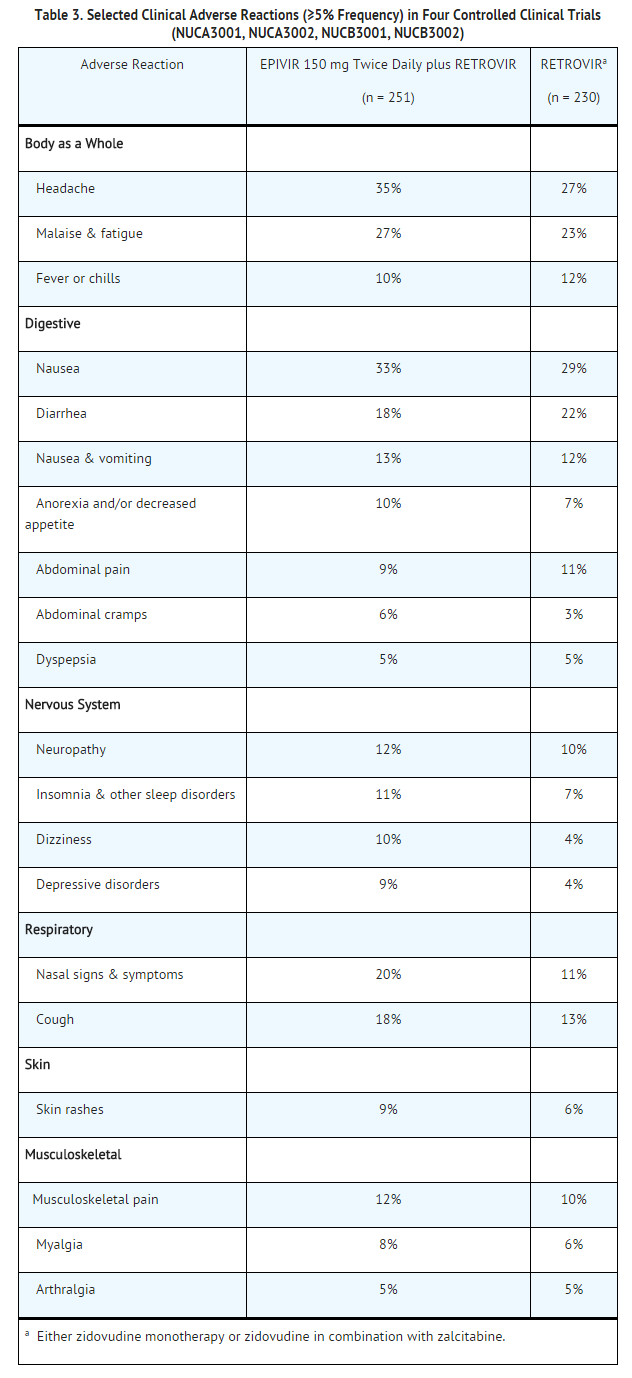
Pancreatitis: Pancreatitis was observed in 9 out of 2,613 adult subjects (0.3%) who received lamivudine in controlled clinical trials.
Lamivudine 300 mg Once Daily: The types and frequencies of clinical adverse reactions reported in subjects receiving lamivudine 300 mg once daily or lamivudine 150 mg twice daily (in 3-drug combination regimens in EPV20001 and EPV40001) for 48 weeks were similar.
Selected laboratory abnormalities observed during therapy are summarized in Table 4.
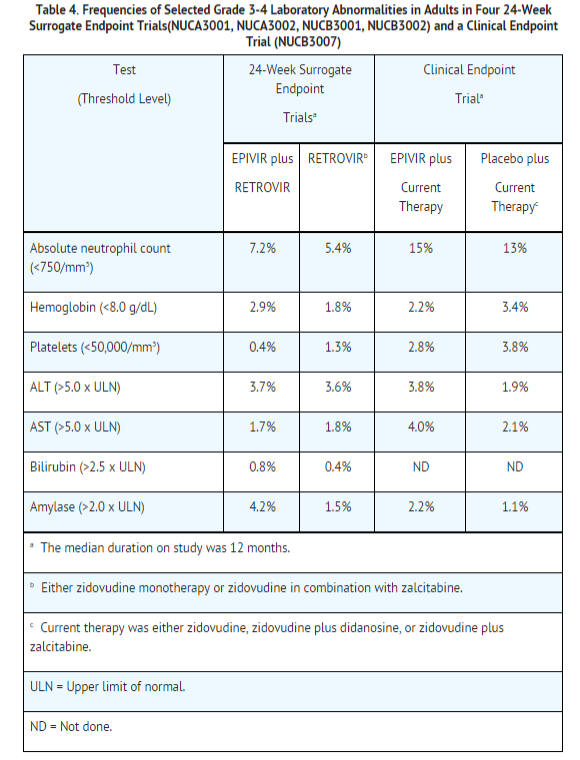
The frequencies of selected laboratory abnormalities reported subjects receiving lamivudine 300 mg once daily or lamivudine 150 mg twice daily (in 3-drug combination regimens in EPV20001 and EPV40001) were similar.
Pediatric Population
Clinical Trials in HIV-1
Lamivudine Oral Solution has been studied in 638 pediatric subjects aged 3 months to 18 years in 3 clinical trials. Selected clinical adverse reactions and physical findings with a ≥5% frequency during therapy with lamivudine 4 mg/kg twice daily plus zidovudine 160 mg/m2 3 times daily in therapy-naive (≤56 days of antiretroviral therapy) pediatric subjects are listed in Table 5.
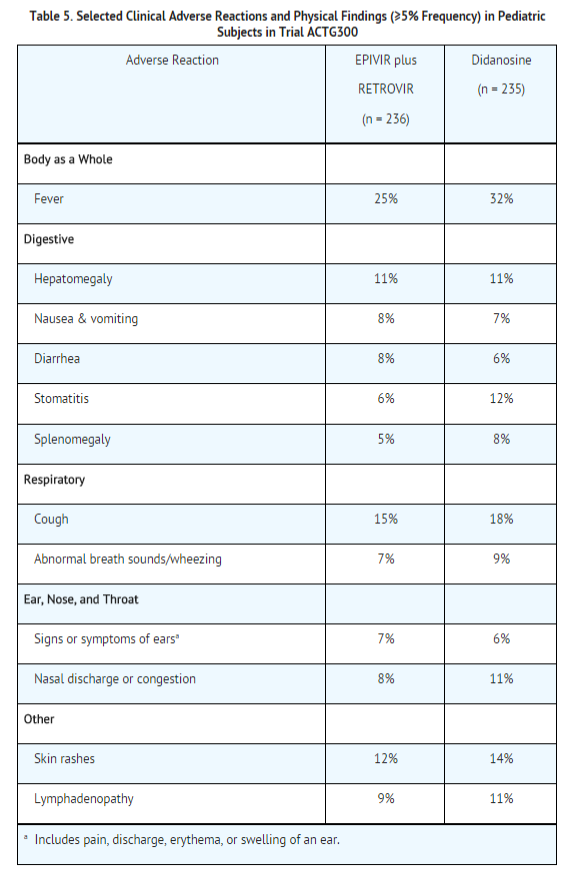
Pancreatitis: Pancreatitis, which has been fatal in some cases, has been observed in antiretroviral nucleoside‑experienced pediatric subjects receiving lamivudine alone or in combination with other antiretroviral agents. In an open‑label dose‑escalation trial (NUCA2002), 14 subjects (14%) developed pancreatitis while receiving monotherapy with lamivudine. Three of these subjects died of complications of pancreatitis. In a second open‑label trial (NUCA2005), 12 subjects (18%) developed pancreatitis. In Trial ACTG300, pancreatitis was not observed in 236 subjects randomized to lamivudine plus zidovudine. Pancreatitis was observed in 1 subject in this trial who received open‑label lamivudine in combination with zidovudin and ritonavir following discontinuation of didanosine monotherapy.
Paresthesias and Peripheral Neuropathies: Paresthesias and peripheral neuropathies were reported in 15 subjects (15%) in Trial NUCA2002, 6 subjects (9%) in Trial NUCA2005, and 2 subjects (<1%) in Trial ACTG300.
Selected laboratory abnormalities experienced by therapy‑naive (56 days of antiretroviral therapy) pediatric subjects are listed in Table 6.
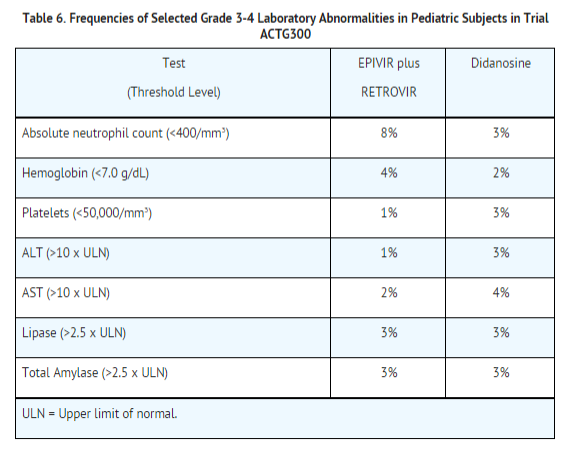
Neonatal Population
Clinical Trials in HIV-1
Limited short-term safety information is available from 2 small, uncontrolled trials in South Africa in neonates receiving lamivudine with or without zidovudine for the first week of life following maternal treatment starting at Week 38 or 36 of gestation. Selected adverse reactions reported in these neonates included increased liver function tests, anemia, diarrhea, electrolyte disturbances, hypoglycemia, jaundice and hepatomegaly, rash, respiratory infections, and sepsis; 3 neonates died (1 from gastroenteritis with acidosis and convulsions, 1 from traumatic injury, and 1 from unknown causes). Two other nonfatal gastroenteritis or diarrhea cases were reported, including 1 with convulsions; 1 infant had transient renal insufficiency associated with dehydration. The absence of control groups limits assessments of causality, but it should be assumed that perinatally exposed infants may be at risk for adverse reactions comparable to those reported in pediatric and adult HIV-1-infected patients treated with lamivudine-containing combination regimens. Long-term effects of in utero and infant lamivudine exposure are not known.
Postmarketing Experience
In addition to adverse reactions reported from clinical trials, the following adverse reactions have been reported during postmarketing use of lamivudine. Because these reactions are reported voluntarily from a population of unknown size, estimates of frequency cannot be made.
Body as a Whole
- Redistribution/accumulation of body fat.
General
Endocrine and Metabolic
Hemic and Lymphatic
- Anemia (including pure red cell aplasia and severe anemias progressing on therapy).
Hepatic and Pancreatic
- Lactic acidosis and hepatic steatosis
- Posttreatment exacerbation of hepatitis B
Hypersensitivity
Musculoskeletal
Skin
Drug Interactions
- Lamivudine is predominantly eliminated in the urine by active organic cationic secretion.
- The possibility of interactions with other drugs administered concurrently should be considered, particularly when their main route of elimination is active renal secretion via the organic cationic transport system (e.g., trimethoprim).
- No data are available regarding interactions with other drugs that have renal clearance mechanisms similar to that of lamivudine.
Interferon- and Ribavirin-Based Regimens
- Although no evidence of a pharmacokinetic or pharmacodynamic interaction (e.g., loss of HIV-1/HCV virologic suppression) was seen when ribavirin was coadministered with lamivudine in HIV-1/HCV co-infected patients, Hepatic decompensation (some fatal) has occurred in HIV-1/HCV co-infected patients receiving combination antiretroviral therapy for HIV-1 and interferon alfa with or without ribavirin.
Zalcitabine
- Lamivudine and zalcitabine may inhibit the intracellular phosphorylation of one another.
- Use of lamivudine in combination with zalcitabine is not recommended.
Trimethoprim/Sulfamethoxazole (TMP-SMX)
- No change in dose of either drug is recommended.
- There is no information regarding the effect on lamivudine pharmacokinetics of higher doses of TMP-SMX such as those used to treat PCP.
Drugs with No Observed Interactions With lamivudine
- A drug interaction trial showed no clinically significant interaction between lamivudine and zidovudine.
Use in Specific Populations
Pregnancy
Pregnancy Category (FDA): C There are no adequate and well-controlled trials of lamivudine in pregnant women. Animal reproduction studies in rats and rabbits revealed no evidence of teratogenicity. Increased early embryolethality occurred in rabbits at exposure levels similar to those in humans. Lamivudine should be used during pregnancy only if the potential benefit justifies the potential risk to the fetus.
Lamivudine pharmacokinetics were studied in pregnant women during 2 clinical trials conducted in South Africa. The trial assessed pharmacokinetics in: 16 women at 36 weeks gestation using 150 mg lamivudine twice daily with zidovudine, 10 women at 38 weeks gestation using 150 mg lamivudine twice daily with zidovudine, and 10 women at 38 weeks gestation using lamivudine 300 mg twice daily without other antiretrovirals. These trials were not designed or powered to provide efficacy information. Lamivudine pharmacokinetics in pregnant women were similar to those seen in non-pregnant adults and in postpartum women. Lamivudine concentrations were generally similar in maternal, neonatal, and umbilical cord serum samples. In a subset of subjects, lamivudine amniotic fluid specimens were collected following natural rupture of membranes. Amniotic fluid concentrations of lamivudine were typically 2 times greater than maternal serum levels and ranged from 1.2 to 2.5 mcg/mL (150 mg twice daily) and 2.1 to 5.2 mcg/mL (300 mg twice daily). It is not known whether risks of adverse events associated with lamivudine are altered in pregnant women compared with other HIV-1-infected patients.
Animal reproduction studies performed at oral doses up to 130 and 60 times the adult dose in rats and rabbits, respectively, revealed no evidence of teratogenicity due to lamivudine. Increased early embryolethality occurred in rabbits at exposure levels similar to those in humans. However, there was no indication of this effect in rats at exposure levels up to 35 times those in humans. Based on animal studies, lamivudine crosses the placenta and is transferred to the fetus.
Antiretroviral Pregnancy Registry: To monitor maternal-fetal outcomes of pregnant women exposed to lamivudine, a Pregnancy Registry has been established.
Pregnancy Category (AUS): B3
There is no Australian Drug Evaluation Committee (ADEC) guidance on usage of Lamivudine in women who are pregnant.
Labor and Delivery
There is no FDA guidance on use of Lamivudine during labor and delivery.
Nursing Mothers
The Centers for Disease Control and Prevention recommend that HIV-1-infected mothers in the United States not breastfeed their infants to avoid risking postnatal transmission of HIV-1 infection. Because of the potential for serious adverse reactions in nursing infants and HIV-1 transmission, mothers should be instructed not to breastfeed if they are receiving lamivudine.
Lamivudine is excreted into human milk. Samples of breast milk obtained from 20 mothers receiving lamivudine monotherapy (300 mg twice daily) or combination therapy (150 mg lamivudine twice daily and 300 mg zidovudine twice daily) had measurable concentrations of lamivudine.
Pediatric Use
The safety and effectiveness of twice-daily lamivudine in combination with other antiretroviral agents have been established in pediatric patients 3 months and older.
Geriatic Use
Clinical trials of lamivudine did not include sufficient numbers of subjects aged 65 and over to determine whether they respond differently from younger subjects. In general, dose selection for an elderly patient should be cautious, reflecting the greater frequency of decreased hepatic, renal, or cardiac function, and of concomitant disease or other drug therapy. In particular, because lamivudine is substantially excreted by the kidney and elderly patients are more likely to have decreased renal function, renal function should be monitored and dosage adjustments should be made accordingly.
Gender
There is no FDA guidance on the use of Lamivudine with respect to specific gender populations.
Race
There is no FDA guidance on the use of Lamivudine with respect to specific racial populations.
Renal Impairment
Dosing of lamivudine is adjusted in accordance with renal function. Dosage adjustments are listed in Table 2.
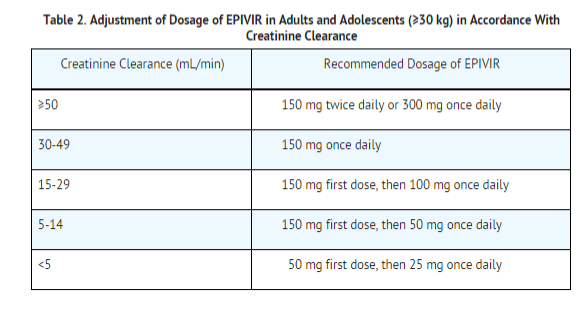
No additional dosing of lamivudine is required after routine (4-hour) hemodialysis or peritoneal dialysis.
Although there are insufficient data to recommend a specific dose adjustment of lamivudine in pediatric patients with renal impairment, a reduction in the dose and/or an increase in the dosing interval should be considered.
Hepatic Impairment
There is no FDA guidance on the use of Lamivudine in patients with hepatic impairment.
Females of Reproductive Potential and Males
There is no FDA guidance on the use of Lamivudine in women of reproductive potentials and males.
Immunocompromised Patients
There is no FDA guidance one the use of Lamivudine in patients who are immunocompromised.
Administration and Monitoring
Administration
- Oral
Monitoring
- Patients with HIV-1 and Hepatitis B Virus Co-infection should be closely monitored with both clinical and laboratory follow-up for at least several months after stopping treatment.
IV Compatibility
There is limited information regarding the compatibility of Lamivudine and IV administrations.
Overdosage
There is no known antidote for lamivudine. One case of an adult ingesting 6 g of lamivudine was reported; there were no clinical signs or symptoms noted and hematologic tests remained normal. Two cases of pediatric overdose were reported in Trial ACTG300. One case involved a single dose of 7 mg/kg of lamivudine; the second case involved use of 5 mg/kg of lamivudine twice daily for 30 days. There were no clinical signs or symptoms noted in either case. Because a negligible amount of lamivudine was removed via (4-hour) hemodialysis, continuous ambulatory peritoneal dialysis, and automated peritoneal dialysis, it is not known if continuous hemodialysis would provide clinical benefit in a lamivudine overdose event. If overdose occurs, the patient should be monitored, and standard supportive treatment applied as required.
Pharmacology
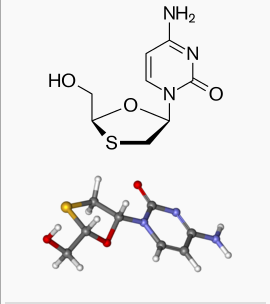
| |
Lamivudine
| |
| Systematic (IUPAC) name | |
| 4-amino-1-[(2R,5S)-2-(hydroxymethyl)-1,3-oxathiolan-5-yl]-1,2-dihydropyrimidin-2-one | |
| Identifiers | |
| CAS number | |
| ATC code | J05 |
| PubChem | |
| DrugBank | |
| Chemical data | |
| Formula | Template:OrganicBox atomTemplate:OrganicBox atomTemplate:OrganicBoxTemplate:OrganicBoxTemplate:OrganicBoxTemplate:OrganicBoxTemplate:OrganicBoxTemplate:OrganicBoxTemplate:OrganicBoxTemplate:OrganicBoxTemplate:OrganicBoxTemplate:OrganicBoxTemplate:OrganicBoxTemplate:OrganicBox atomTemplate:OrganicBoxTemplate:OrganicBox atomTemplate:OrganicBoxTemplate:OrganicBoxTemplate:OrganicBox atomTemplate:OrganicBoxTemplate:OrganicBoxTemplate:OrganicBoxTemplate:OrganicBox |
| Mol. mass | 229.26 g/mol |
| SMILES | & |
| Synonyms | L-2′,3′-dideoxy-3′-thiacytidine |
| Pharmacokinetic data | |
| Bioavailability | 86% |
| Protein binding | Less than 36% |
| Metabolism | ? |
| Half life | 5 to 7 hours |
| Excretion | Renal (circa 70%) |
| Therapeutic considerations | |
| Pregnancy cat. | |
| Legal status |
POM(UK) [[Prescription drug|Template:Unicode-only]](US) |
| Routes | Oral |
Mechanism of Action
- Lamivudine is an antiviral agent.
- Intracellularly, lamivudine is phosphorylated to its active 5′-triphosphate metabolite, lamivudine triphosphate (3TC-TP).
- The principal mode of action of 3TC-TP is the inhibition of HIV-1 reverse transcriptase (RT) via DNA chain termination after incorporation of the nucleotide analogue into viral DNA.
- 3TC-TP is a weak inhibitor of mammalian DNA polymerases α, β, and γ.
Structure
- Lamivudine is a synthetic nucleoside analogue with activity against HIV-1 and HBV.
- The chemical name of lamivudine is (2R,cis)-4-amino-1-(2-hydroxymethyl-1,3-oxathiolan-5-yl)-(1H)-pyrimidin-2-one.
- Lamivudine is the (-)enantiomer of a dideoxy analogue of cytidine. *Lamivudine has also been referred to as (-)2′,3′-dideoxy, 3′-thiacytidine.
- It has a molecular formula of C8H11N3O3S and a molecular weight of 229.3.
- Lamivudine is a white to off-white crystalline solid with a solubility of approximately 70 mg/mL in water at 20°C.
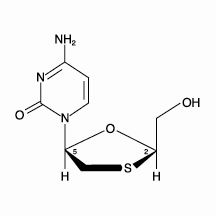
Pharmacodynamics
- There is limited information regarding Pharmacodynamics of lamivudine in the drug label.
Pharmacokinetics
Pharmacokinetics in Adults
- The pharmacokinetic properties of lamivudine have been studied in asymptomatic, HIV-1-infected adult subjects after administration of single intravenous (IV) doses ranging from 0.25 to 8 mg/kg, as well as single and multiple (twice-daily regimen) oral doses ranging from 0.25 to 10 mg/kg.
- The pharmacokinetic properties of lamivudine have also been studied as single and multiple oral doses ranging from 5 mg to 600 mg/day administered to HBV-infected subjects.
- The steady-state pharmacokinetic properties of the lamivudine 300-mg tablet once daily for 7 days compared with the lamivudine 150-mg tablet twice daily for 7 days were assessed in a crossover trial in 60 healthy subjects.
- Lamivudine 300 mg once daily resulted in lamivudine exposures that were similar to lamivudine 150 mg twice daily with respect to plasma AUC24,ss; however, Cmax,ss was 66% higher and the trough value was 53% lower compared with the 150-mg twice-daily regimen.
- Intracellular lamivudine triphosphate exposures in peripheral blood mononuclear cells were also similar with respect to AUC24,ss and Cmax24,ss; however, trough values were lower compared with the 150-mg twice-daily regimen. *Inter-subject variability was greater for intracellular lamivudine triphosphate concentrations versus lamivudine plasma trough concentrations.
- The clinical significance of observed differences for both plasma lamivudine concentrations and intracellular lamivudine triphosphate concentrations is not known.
Absorption and Bioavailability
- Lamivudine was rapidly absorbed after oral administration in HIV-1-infected subjects.
- Absolute bioavailability in 12 adult subjects was 86% ± 16% (mean ± SD) for the 150-mg tablet and 87% ± 13% for the oral solution.
- After oral administration of 2 mg/kg twice a day to 9 adults with HIV-1, the peak serum lamivudine concentration (Cmax) was 1.5 ± 0.5 mcg/mL (mean ± SD).
- The area under the plasma concentration versus time curve (AUC) and Cmax increased in proportion to oral dose over the range from 0.25 to 10 mg/kg.
- The accumulation ratio of lamivudine in HIV-1-positive asymptomatic adults with normal renal function was 1.50 following 15 days of oral administration of 2 mg/kg twice daily.
Effects of Food on Oral Absorption
- An investigational 25-mg dosage form of lamivudine was administered orally to 12 asymptomatic, HIV-1-infected subjects on 2 occasions, once in the fasted state and once with food (1,099 kcal; 75 grams fat, 34 grams protein, 72 grams carbohydrate). Absorption of lamivudine was slower in the fed state (Tmax: 3.2 ± 1.3 hours) compared with the fasted state (Tmax: 0.9 ± 0.3 hours); Cmax in the fed state was 40% ± 23% (mean ± SD) lower than in the fasted state. There was no significant difference in systemic exposure (AUC∞) in the fed and fasted states; therefore, lamivudine Tablets and Oral Solution may be administered with or without food.
Distribution
- The apparent volume of distribution after IV administration of lamivudine to 20 subjects was 1.3 ± 0.4 L/kg, suggesting that lamivudine distributes into extravascular spaces.
- Volume of distribution was independent of dose and did not correlate with body weight.
- Binding of lamivudine to human plasma proteins is low (<36%).
- In vitro studies showed that over the concentration range of 0.1 to 100 mcg/mL, the amount of lamivudine associated with erythrocytes ranged from 53% to 57% and was independent of concentration.
Metabolism
- Metabolism of lamivudine is a minor route of elimination.
- In man, the only known metabolite of lamivudine is the trans-sulfoxide metabolite. Within 12 hours after a single oral dose of lamivudine in 6 HIV-1-infected adults, 5.2% ± 1.4% (mean ± SD) of the dose was excreted as the trans-sulfoxide metabolite in the urine. Serum concentrations of this metabolite have not been determined.
Elimination
- The majority of lamivudine is eliminated unchanged in urine by active organic cationic secretion.
- In 9 healthy subjects given a single 300-mg oral dose of lamivudine, renal clearance was 199.7 ± 56.9 mL/min (mean ± SD).
- In 20 HIV-1-infected subjects given a single IV dose, renal clearance was 280.4 ± 75.2 mL/min (mean ± SD), representing 71% ± 16% (mean ± SD) of total clearance of lamivudine.
- In most single-dose trials in HIV-1-infected subjects, HBV‑infected subjects, or healthy subjects with serum sampling for 24 hours after dosing, the observed mean elimination half-life (t½) ranged from 5 to 7 hours.
- In HIV-1-infected subjects, total clearance was 398.5 ± 69.1 mL/min (mean ± SD).
- Oral clearance and elimination half-life were independent of dose and body weight over an oral dosing range of 0.25 to 10 mg/kg.
Special Populations
Renal Impairment
- The pharmacokinetic properties of lamivudine have been determined in a small group of HIV-1-infected adults with impaired renal function (Table 7).
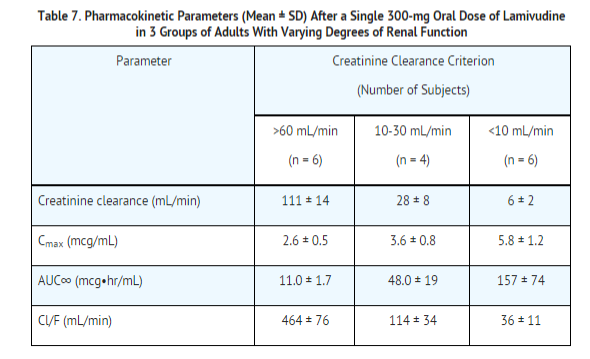
- Exposure (AUC∞), Cmax, and half-life increased with diminishing renal function (as expressed by creatinine clearance).
- Apparent total oral clearance (Cl/F) of lamivudine decreased as creatinine clearance decreased. Tmax was not significantly affected by renal function. *Based on these observations, it is recommended that the dosage of lamivudine be modified in patients with renal impairment.
- Based on a trial in otherwise healthy subjects with impaired renal function, hemodialysis increased lamivudine clearance from a mean of 64 to 88 mL/min; however, the length of time of hemodialysis (4 hours) was insufficient to significantly alter mean lamivudine exposure after a single-dose administration.
- Continuous ambulatory peritoneal dialysis and automated peritoneal dialysis have negligible effects on lamivudine clearance. Therefore, it is recommended, following correction of dose for creatinine clearance, that no additional dose modification be made after routine hemodialysis or peritoneal dialysis.
- It is not known whether lamivudine can be removed by continuous (24-hour) hemodialysis.
- The effects of renal impairment on lamivudine pharmacokinetics in pediatric patients are not known.
Hepatic Impairment
- The pharmacokinetic properties of lamivudine have been determined in adults with impaired hepatic function.
- Pharmacokinetic parameters were not altered by diminishing hepatic function; therefore, no dose adjustment for lamivudine is required for patients with impaired hepatic function.
- Safety and efficacy of lamivudine have not been established in the presence of decompensated liver disease.
Pharmacokinetics in Pediatric Patients
- In Trial NUCA2002, pharmacokinetic properties of lamivudine were assessed in a subset of 57 HIV-1-infected pediatric subjects (age range: 4.8 months to 16 years, weight range: 5 to 66 kg) after oral and IV administration of 1, 2, 4, 8, 12, and 20 mg/kg/day.
- In the 9 infants and children (age range: 5 months to 12 years) receiving oral solution 4 mg/kg twice daily (the usual recommended pediatric dose), absolute bioavailability was 66% ± 26% (mean ± SD), which was less than the 86% ± 16% (mean ± SD) observed in adults.
- The mechanism for the diminished absolute bioavailability of lamivudine in infants and children is unknown.
Systemic clearance decreased with increasing age in pediatric subjects, as shown in Figure 1.
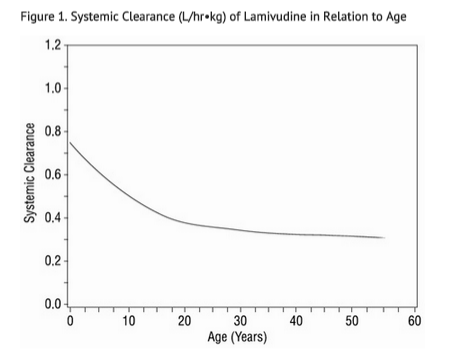
- After oral administration of lamivudine 4 mg/kg twice daily to 11 pediatric subjects ranging in age from 4 months to 14 years, Cmax was 1.1 ± 0.6 mcg/mL and half-life was 2.0 ± 0.6 hours. (In adults with similar blood sampling, the half‑life was 3.7 ± 1 hours.)
- Total exposure to lamivudine, as reflected by mean AUC values, was comparable between pediatric subjects receiving an 8-mg/kg/day dose and adults receiving a 4-mg/kg/day dose.
- Distribution of lamivudine into cerebrospinal fluid (CSF) was assessed in 38 pediatric subjects after multiple oral dosing with lamivudine.
- CSF samples were collected between 2 and 4 hours postdose.
- At the dose of 8 mg/kg/day, CSF lamivudine concentrations in 8 subjects ranged from 5.6% to 30.9% (mean ± SD of 14.2% ± 7.9%) of the concentration in a simultaneous serum sample, with CSF lamivudine concentrations ranging from 0.04 to 0.3 mcg/mL.
- Limited, uncontrolled pharmacokinetic and safety data are available from administration of lamivudine (and zidovudine) to 36 infants aged up to 1 week in 2 trials in South Africa. In these trials, lamivudine clearance was substantially reduced in 1-week-old neonates relative to pediatric subjects (aged >3 months) studied previously.
- There is insufficient information to establish the time course of changes in clearance between the immediate neonatal period and the age-ranges >3 months old.
Pharmacokinetics in Geriatric Patients
- The pharmacokinetics of lamivudine after administration of lamivudine to patients over 65 years have not been studied.
Drug Interactions
Interferon Alfa
- There was no significant pharmacokineti interaction between lamivudine and interferon alfa in a trial of 19 healthy male subjects.
Ribavirin
- In vitro data indicate ribavirin reduces phosphorylation of lamivudine, stavudine, and zidovudine. However, no pharmacokinetic (e.g., plasma concentrations or intracellular triphosphorylated active metabolite concentrations) or pharmacodynamic (e.g., loss of HIV-1/HCV virologic suppression) interaction was observed when ribavirin and lamivudine (n = 18), stavudine (n = 10), or zidovudine (n = 6) were coadministered as part of a multi-drug regimen to HIV-1/HCV co-infected subjects.
Trimethoprim/Sulfamethoxazole
- Lamivudine and TMP-SMX were coadministered to 14 HIV-1-positive subjects in a single-center, open-label, randomized, crossover trial. Each subject received treatment with a single 300-mg dose of lamivudine and TMP 160 mg/SMX 800 mg once a day for 5 days with concomitant administration of lamivudine 300 mg with the fifth dose in a crossover design.
- Coadministration of TMP-SMX with lamivudine resulted in an increase of 43% ± 23% (mean ± SD) in lamivudine AUC∞, a decrease of 29% ± 13% in lamivudine oral clearance, and a decrease of 30% ± 36% in lamivudine renal clearance. *The pharmacokinetic properties of TMP and SMX were not altered by coadministration with lamivudine.
Zidovudine
- No clinically significant alterations in lamivudine or zidovudine pharmacokinetics were observed in 12 asymptomatic HIV-1-infected adult subjects given a single dose of zidovudine (200 mg) in combination with multiple doses of lamivudine (300 mg q 12 hr).
Nonclinical Toxicology
Carcinogenesis, Mutagenesis, Impairment of Fertility
Long-term carcinogenicity studies with lamivudine in mice and rats showed no evidence of carcinogenic potential at exposures up to 10 times (mice) and 58 times (rats) those observed in humans at the recommended therapeutic dose for HIV-1 infection. Lamivudine was not active in a microbial mutagenicity screen or an in vitro cell transformation assay, but showed weak in vitro mutagenic activity in a cytogenetic assay using cultured human lymphocytes and in the mouse lymphoma assay. However, lamivudine showed no evidence of in vivo genotoxic activity in the rat at oral doses of up to 2,000 mg/kg, producing plasma levels of 35 to 45 times those in humans at the recommended dose for HIV-1 infection. In a study of reproductive performance, lamivudine administered to rats at doses up to 4,000 mg/kg/day, producing plasma levels 47 to 70 times those in humans, revealed no evidence of impaired fertility and no effect on the survival, growth, and development to weaning of the offspring.
Reproductive Toxicology Studies
Reproduction studies have been performed in rats and rabbits at orally administered doses up to 4,000 mg/kg/day and 1,000 mg/kg/day, respectively, producing plasma levels up to approximately 35 times that for the adult HIV dose. No evidence of teratogenicity due to lamivudine was observed. Evidence of early embryolethality was seen in the rabbit at exposure levels similar to those observed in humans, but there was no indication of this effect in the rat at exposure levels up to 35 times those in humans. Studies in pregnant rats and rabbits showed that lamivudine is transferred to the fetus through the placenta.
Clinical Studies
The use of lamivudine is based on the results of clinical trials in HIV‑1-infected subjects in combination regimens with other antiretroviral agents. Information from trials with clinical endpoints or a combination of CD4+ cell counts and HIV-1 RNA measurements is included below as documentation of the contribution of lamivudine to a combination regimen in controlled trials.
Adults
Clinical Endpoint Trial
NUCB3007 (CAESAR) was a multi-center, double-blind, placebo-controlled trial comparing continued current therapy (zidovudine alone [62% of subjects] or zidovudine with didanosine or zalcitabine [38% of subjects]) to the addition of lamivudine or lamivudine plus an investigational non-nucleoside reverse transcriptase inhibitor (NNRTI), randomized 1:2:1. A total of 1,816 HIV-1-infected adults with 25 to 250 CD4+ cells/mm3 (median = 122 cells/mm3) at baseline were enrolled: median age was 36 years, 87% were male, 84% were nucleoside-experienced, and 16% were therapy-naive. The median duration on trial was 12 months. Results are summarized in Table 8.
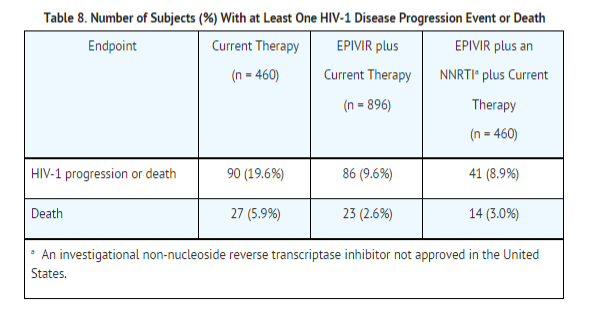
Surrogate Endpoint Trials
Dual Nucleoside Analogue Trials:
Principal clinical trial in the initial development of lamivudine compared lamivudine/zidovudine combinations with zidovudine monotherapy or with zidovudine plus zalcitabine. These trials demonstrated the antiviral effect of lamivudine in a 2-drug combination. More recent uses of lamivudine in treatment of HIV-1 infection incorporate it into multiple-drug regimens containing at least 3 antiretroviral drugs for enhanced viral suppression.
Dose Regimen Comparison Surrogate Endpoint Trials in Therapy-Naive Adults:
EPV20001 was a multi-center, double-blind, controlled trial in which subjects were randomized 1:1 to receive lamivudine 300 mg once daily or lamivudine 150 mg twice daily, in combination with zidovudine 300 mg twice daily and efavirenz 600 mg once daily. A total of 554 antiretroviral treatment-naive HIV-1-infected adults enrolled: male (79%), Caucasian (50%), median age of 35 years, baseline CD4+ cell counts of 69 to 1,089 cells/mm3 (median = 362 cells/mm3), and median baseline plasma HIV-1 RNA of 4.66 log10 copies/mL. Outcomes of treatment through 48 weeks are summarized in Figure 2 and Table 9.
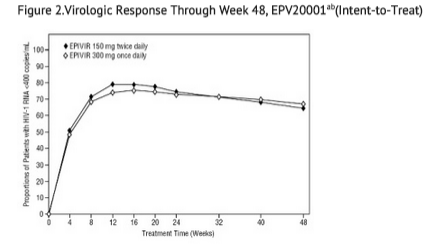
Roche AMPLICOR HIV-1 MONITOR.
Responders at each visit are subjects who had achieved and maintained HIV-1 RNA <400 copies/mL without discontinuation by that visit.
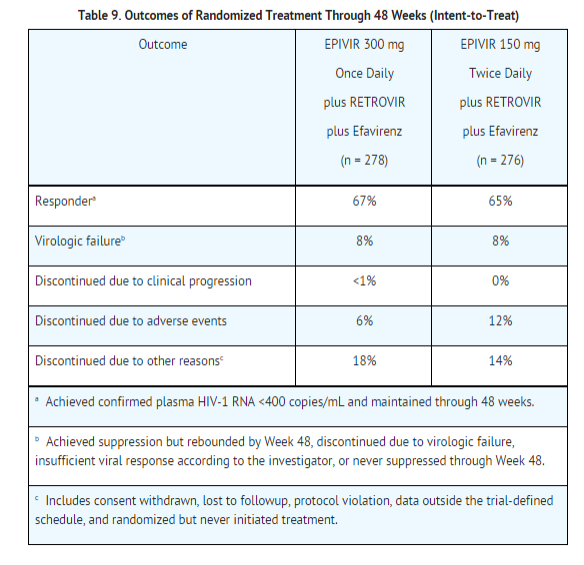
The proportions of subjects with HIV-1 RNA <50 copies/mL (via Roche Ultrasensitive assay) through Week 48 were 61% for subjects receiving lamivudine 300 mg once daily and 63% for subjects receiving lamivudine 150 mg twice daily. Median increases in CD4+ cell counts were 144 cells/mm3 at Week 48 in subjects receiving lamivudine 300 mg once daily and 146 cells/mm3for subjects receiving lamivudine 150 mg twice daily.
A small, randomized, open-label pilot trial, EPV40001, was conducted in Thailand. A total of 159 treatment-naive adult subjects (male 32%, Asian 100%, median age 30 years, baseline median CD4+ cell count 380 cells/mm3, median plasma HIV-1 RNA 4.8 log10 copies/mL) were enrolled. Two of the treatment arms in this trial provided a comparison between lamivudine 300 mg once daily (n = 54) and lamivudine 150 mg twice daily (n = 52), each in combination with zidovudine 300 mg twice daily and abacavir 300 mg twice daily. In intent-to-treat analyses of 48-week data, the proportions of subjects with HIV-1 RNA below 400 copies/mL were 61% (33/54) in the group randomized to once-daily lamivudine and 75% (39/52) in the group randomized to receive all 3 drugs twice daily; the proportions with HIV-1 RNA below 50 copies/mL were 54% (29/54) in the once-daily lamivudine group and 67% (35/52) in the all-twice-daily group; and the median increases in CD4+ cell counts were 166 cells/mm3 in the once-daily lamivudine group and 216 cells/mm3 in the all-twice-daily group.
Pediatric Subjects
Clinical Endpoint Trial:
ACTG300 was a multi-center, randomized, double-blind trial that provided for comparison of lamivudine plus zidovudine with didanosine monotherapy. A total of 471 symptomatic, HIV-1-infected therapy-naive (56 days of antiretroviral therapy) pediatric subjects were enrolled in these 2 treatment arms. The median age was 2.7 years (range: 6 weeks to 14 years), 58% were female, and 86% were non-Caucasian. The mean baseline CD4+ cell count was 868 cells/mm3 (mean: 1,060 cells/mm3 and range:0 to 4,650 cells/mm3 for subjects aged 5 years; mean: 419 cells/mm3 and range: 0 to 1,555 cells/mm3 for subjects aged >5 years) and the mean baseline plasma HIV-1 RNA was 5.0 log10 copies/mL. The median duration on trial was 10.1 months for the subjects receiving lamivudine plus zidovudine and 9.2 months for subjects receiving didanosine monotherapy.
Results are summarized in Table 10.
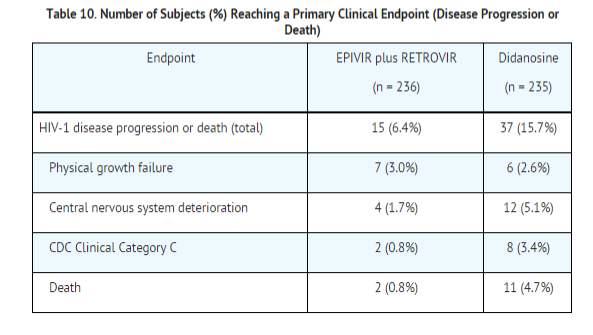
How Supplied
Lamivudine Tablets, 150 mg
- White, diamond-shaped, scored, film-coated tablets debossed with “GX CJ7” on both sides.
- Bottle of 60 tablets (NDC 49702-203-18) with child-resistant closure.
Lamivudine Tablets, 300 mg
- Gray, modified diamond-shaped, film-coated tablets engraved with “GX EJ7” on one side and plain on the reverse side.
- Bottle of 30 tablets (NDC 49702-204-13) with child-resistant closure.
Lamivunide Oral Solution, 10 mg/mL
- A clear, colorless to pale yellow, strawberry-banana-flavored liquid, contains 10 mg of lamivudine in each 1 mL.
- Plastic bottle of 240 mL (NDC 49702-205-48) with child-resistant closure. This product does not require reconstitution.
Storage
Lamivudine tablets
- Store Lamivudine Tablets at 25°C (77°F); excursions permitted to 15° to 30°C (59° to 86°F).
Lamivudine oral solution
- Store in tightly closed bottles at 25°C (77°F).
Images
Drug Images
{{#ask: Page Name::Lamivudine |?Pill Name |?Drug Name |?Pill Ingred |?Pill Imprint |?Pill Dosage |?Pill Color |?Pill Shape |?Pill Size (mm) |?Pill Scoring |?NDC |?Drug Author |format=template |template=DrugPageImages |mainlabel=- |sort=Pill Name }}
Package and Label Display Panel
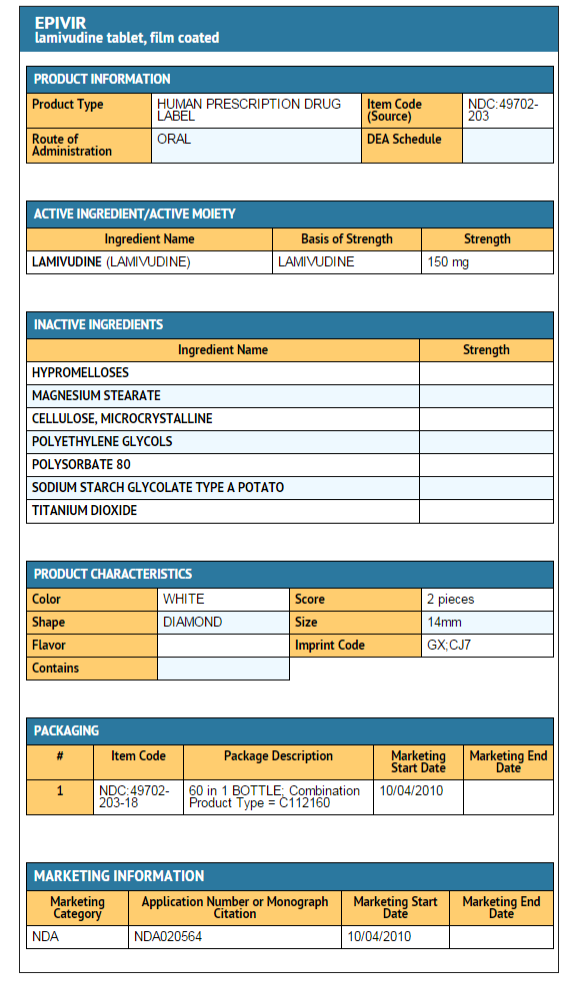
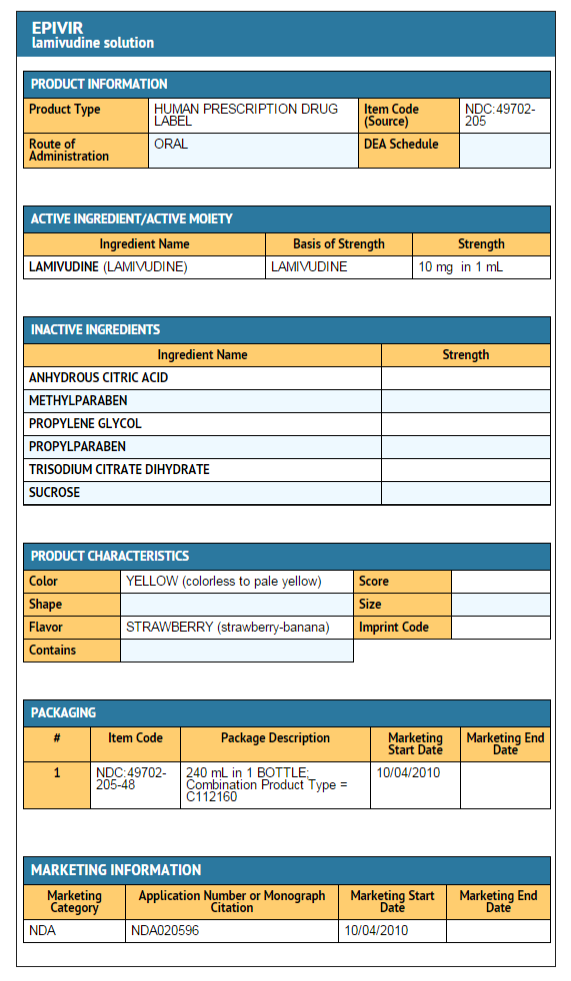

{{#ask: Label Page::Lamivudine |?Label Name |format=template |template=DrugLabelImages |mainlabel=- |sort=Label Page }}
Patient Counseling Information
Advice for the Patient
Lactic Acidosis/Hepatomegaly
- Patients should be informed that some HIV medicines, including lamivudine, can cause a rare, but serious condition called lactic acidosis with liver enlargement (hepatomegaly).
HIV-1/HBV Co-infection
- Patients co-infected with HIV-1 and HBV should be informed that deterioration of liver disease has occurred in some cases when treatment with lamivudine was discontinued.
- Patients should be advised to discuss any changes in regimen with their physician.
Differences in Formulations of lamivudine
Patients should be advised that lamivudine Tablets and Oral Solution contain a higher dose of the same active ingredient (lamivudine) as lamivudine-HBV Tablets and Oral Solution. If a decision is made to include lamivudine in the HIV-1 treatment regimen of a patient co-infected with HIV-1 and HBV, the formulation and dosage of lamivudine in lamivudine (not lamivudine-HBV) should be used.
Use With Other Lamivudine- and Emtricitabine-Containing Products
Lamivudine should not be coadministered with drugs containing lamivudine or emtricitabine, including lamivudine/zidovudine Tablets, abacavir sulfate and lamivudine Tablets, abacavir sulfate, lamivudine, and zidovudine, efavirenz, emtricitabine, and tenofovir, [emtricitabine], emtricitabine and tenofovir, or rilpivirine/emtricitabine/tenofovir.
HIV-1/HCV Co-Infection
Patients with HIV-1/HCV co-infection should be informed that hepatic decompensation (some fatal) has occurred in HIV-1/HCV co-infected patients receiving combination antiretroviral therapy for HIV-1 and interferon alfa with or without ribavirin.
Risk of Pancreatitis
Parents or guardians should be advised to monitor pediatric patients for signs and symptoms of pancreatitis.
Redistribution/Accumulation of Body Fat
Patients should be informed that redistribution or accumulation of body fat may occur in patients receiving antiretroviral therapy, including lamivudine, and that the cause and long-term health effects of these conditions are not known at this time.
Sucrose Content of lamivudine Oral Solution
Diabetic patients should be advised that each 15-mL dose of lamivudine Oral Solution contains 3 grams of sucrose.
Information About HIV-1 Infection
Lamivudine is not a cure for HIV-1 infection and patients may continue to experience illnesses associated with HIV-1 infection, including opportunistic infections. Patients should remain under the care of a physician when using lamivudine.
Patients should be advised to avoid doing things that can spread HIV-1 infection to others.
- Do not share needles or other injection equipment.
- Do not share personal items that can have blood or body fluids on them, like toothbrushes and razor blades.
- Do not have any kind of sex without protection.
- Always practice safe sex by using a latex or polyurethane condom or other barrier method to lower the chance of sexual contact with semen, vaginal secretions, or blood.
- Do not breastfeed. Lamivudine is excreted in human breast milk. Mothers with HIV-1 should not breastfeed because HIV-1 can be passed to the baby in the breast milk.
- Patients should be informed to take all HIV medications exactly as prescribed.
Precautions with Alcohol
Alcohol-lamivudine interaction has not been established. Talk to your doctor about the effects of taking alcohol with this medication.
Brand Names
- EPIVIR[2]
- EPIVIR HBV
- EPIVIR A/F
Look-Alike Drug Names
There is limited information regarding Lamivudine Look-Alike Drug Names in the drug label.
Drug Shortage Status
Price
References
The contents of this FDA label are provided by the National Library of Medicine.
- ↑ Jiang L, Yan L, Li B, Wen T, Zhao J, Jiang L; et al. (2010). "Prophylaxis against hepatitis B recurrence posttransplantation using lamivudine and individualized low-dose hepatitis B immunoglobulin". Am J Transplant. 10 (8): 1861–9. doi:10.1111/j.1600-6143.2010.03208.x. PMID 20659092.
- ↑ "lamivudine- lamivudine tablet, film coated. lamivudine- lamivudine solution".
{{#subobject:
|Label Page=Lamivudine |Label Name=Lamivudine Package Tablets 1.png
}}
{{#subobject:
|Label Page=Lamivudine |Label Name=Lamivudine Package Tablets 2.png
}}
{{#subobject:
|Label Page=Lamivudine |Label Name=Lamivudine Package Oral Solution.png
}}